Designing a small living room that feels both cozy and spacious is a common challenge for many homeowners. The key is to maximize every square inch without creating clutter. From smart furniture choices to clever color palettes and strategic lighting, there are numerous ways to transform a compact area into a comfortable and inviting hub for relaxation and socializing. Embracing minimalist principles while incorporating personal style can turn a tiny footprint into a functional and aesthetically pleasing space. These ideas will help you unlock the full potential of your cozy living room, making it feel larger and more welcoming than you ever thought possible.
1. Small Living Room with Floating Shelves
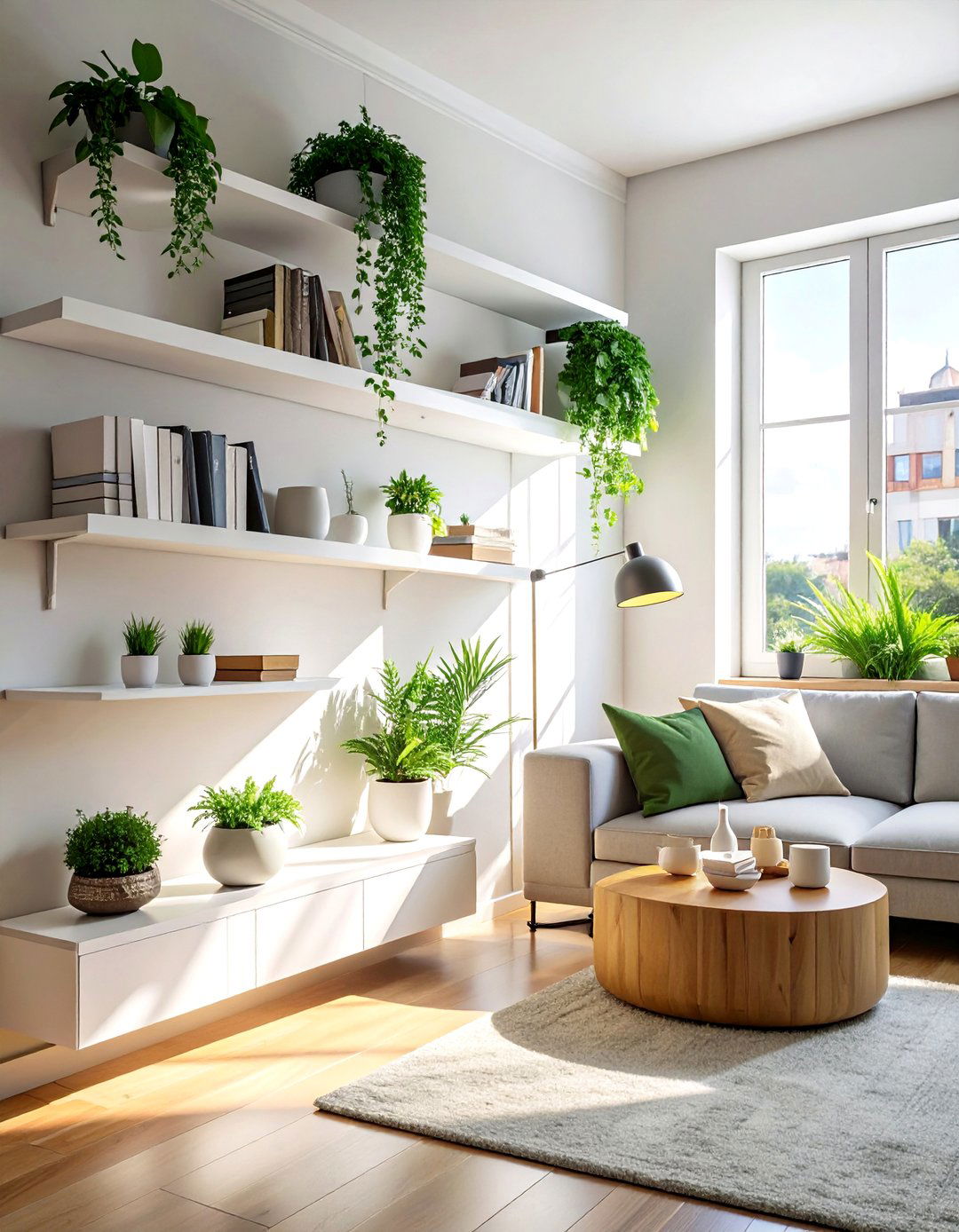
Floating shelves are a game-changer for small living rooms, offering valuable storage and display space without consuming any floor area. Unlike bulky bookcases, these sleek shelves mount directly to the wall, creating a clean, minimalist look that enhances the sense of openness. Use them to showcase decorative items, books, or small plants, drawing the eye upward and making the ceiling feel higher. Arrange them in a symmetrical pattern for a formal look or an asymmetrical layout for a more dynamic, modern feel. This approach not-only declutters surfaces but also adds a layer of visual interest and personality to your walls.
2. Small Living Room with a Round Coffee Table
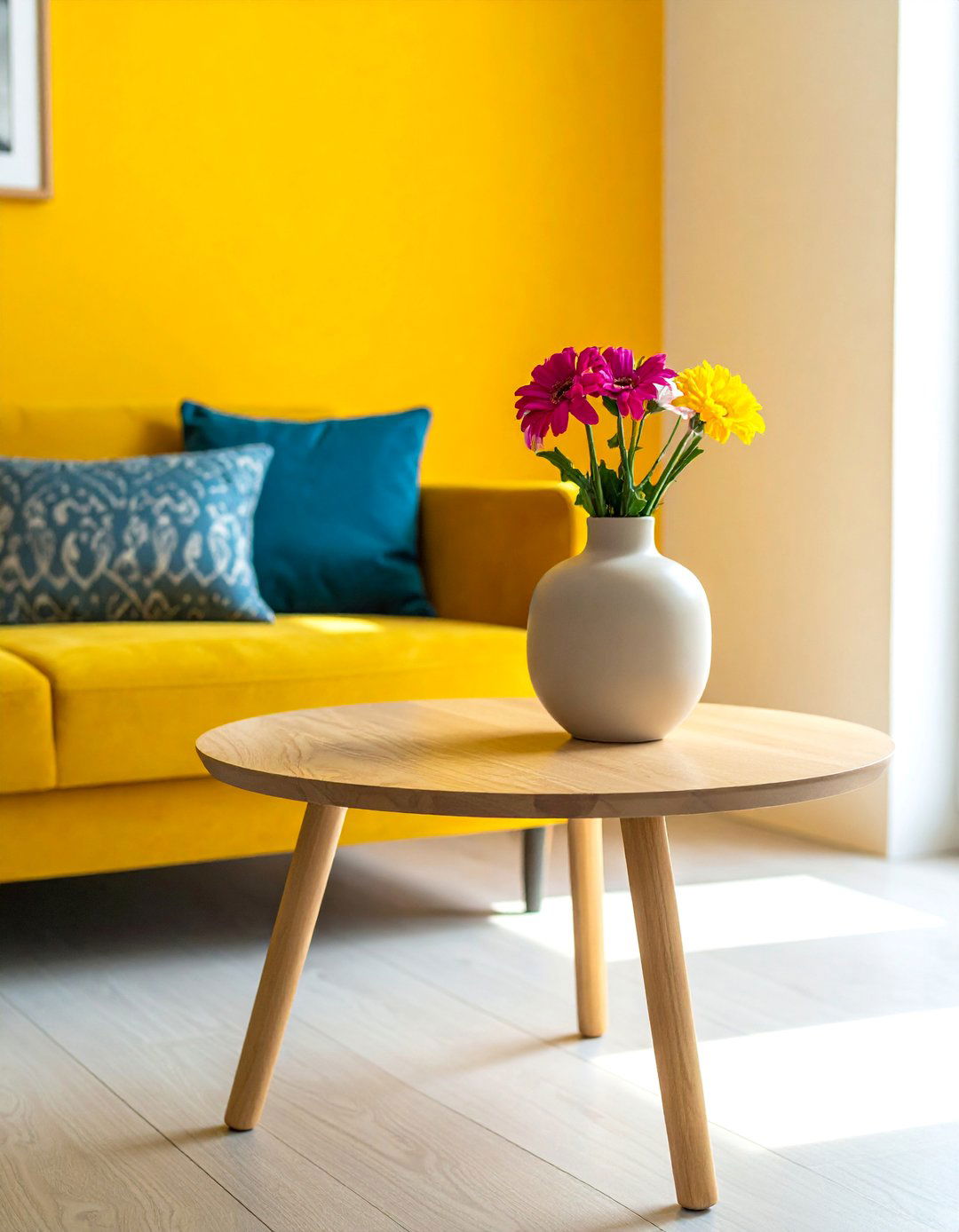
A round coffee table is an excellent choice for a small living room as its lack of sharp corners creates better traffic flow and a softer, more inviting aesthetic. This design choice makes the room feel less cramped and is safer in tight quarters, especially for households with children. Round tables, whether made of wood, glass, or metal, occupy less visual space than their square or rectangular counterparts. A glass-topped version can further enhance this effect by allowing light to pass through, creating an illusion of more open floor space. It serves as a functional centerpiece without overwhelming the room's proportions.
3. Small Living Room with a Large Area Rug
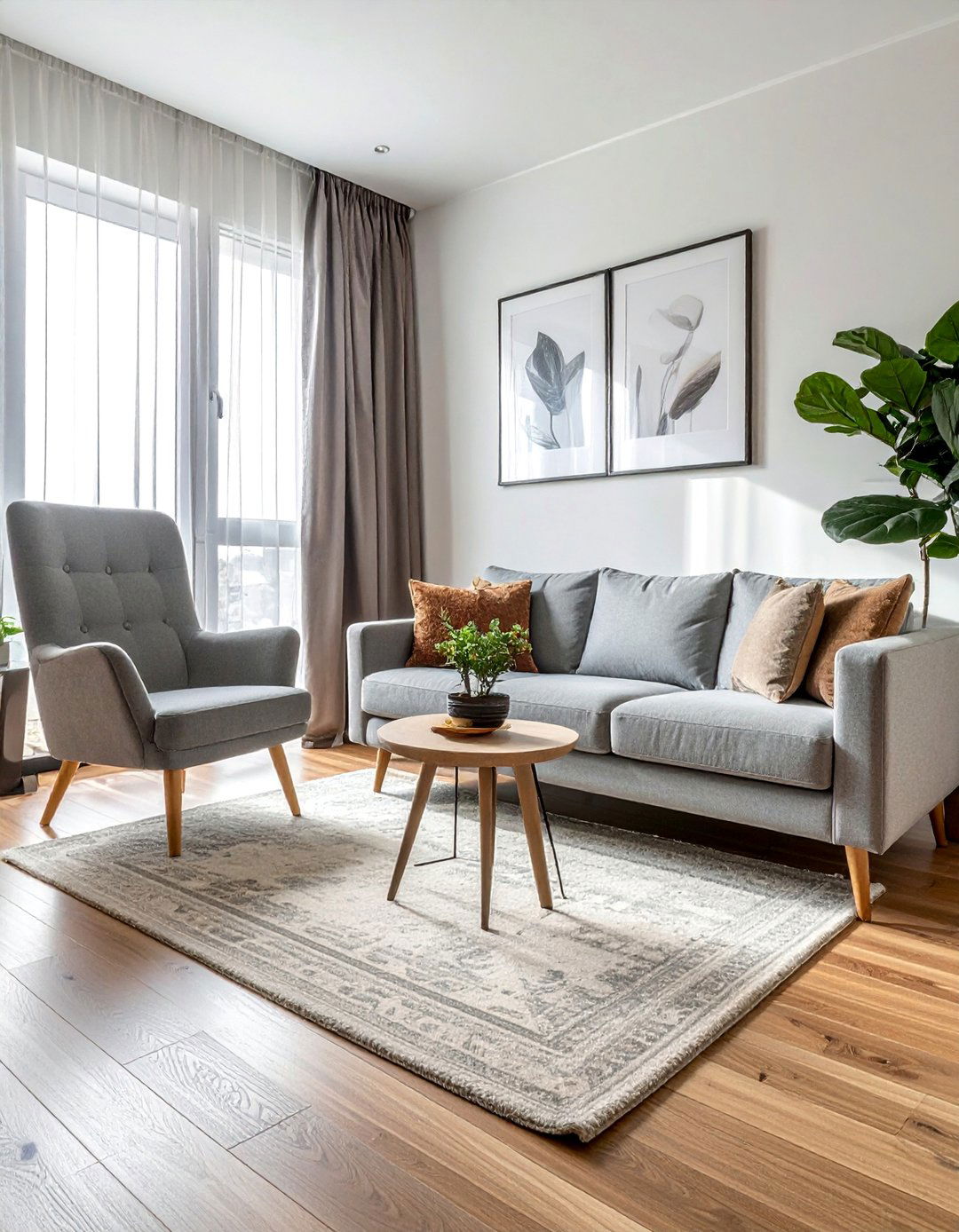
Using a large area rug in a small living room can surprisingly make the space feel bigger. A common mistake is using a small rug that "floats" in the middle of the floor, which can visually shrink the room. Instead, choose a rug that is large enough for the front legs of all your main furniture pieces—sofa, chairs, and tables—to rest on it. This technique unifies the furniture arrangement and creates a cohesive, well-defined seating area, anchoring the room and establishing a sense of grandeur. A light-colored or subtly patterned rug can also contribute to a brighter, more open atmosphere.
4. Small Living Room with Mirrored Walls
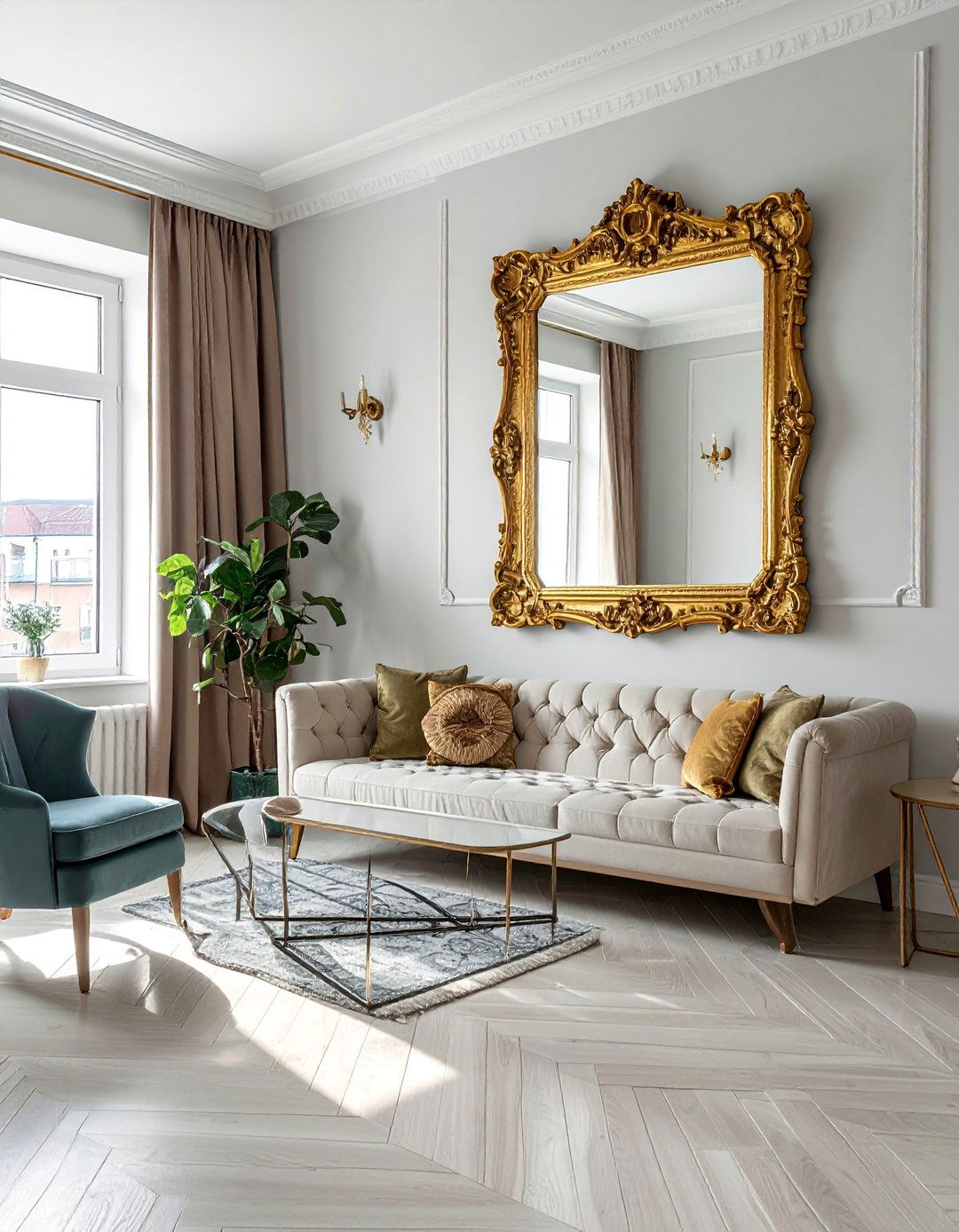
Incorporating a large mirror or a collection of smaller mirrors is a classic trick to make a small living room feel more expansive. Mirrors reflect both natural and artificial light, instantly brightening the space and creating an illusion of depth. Placing a large mirror on the wall opposite a window is particularly effective, as it bounces light around the room and brings a sense of the outdoors inside. You can opt for a single oversized, statement mirror as a focal point or create a gallery wall of smaller, decorative mirrors for a more eclectic and artistic touch, adding both function and style.
5. Small Living Room with a Sectional Sofa
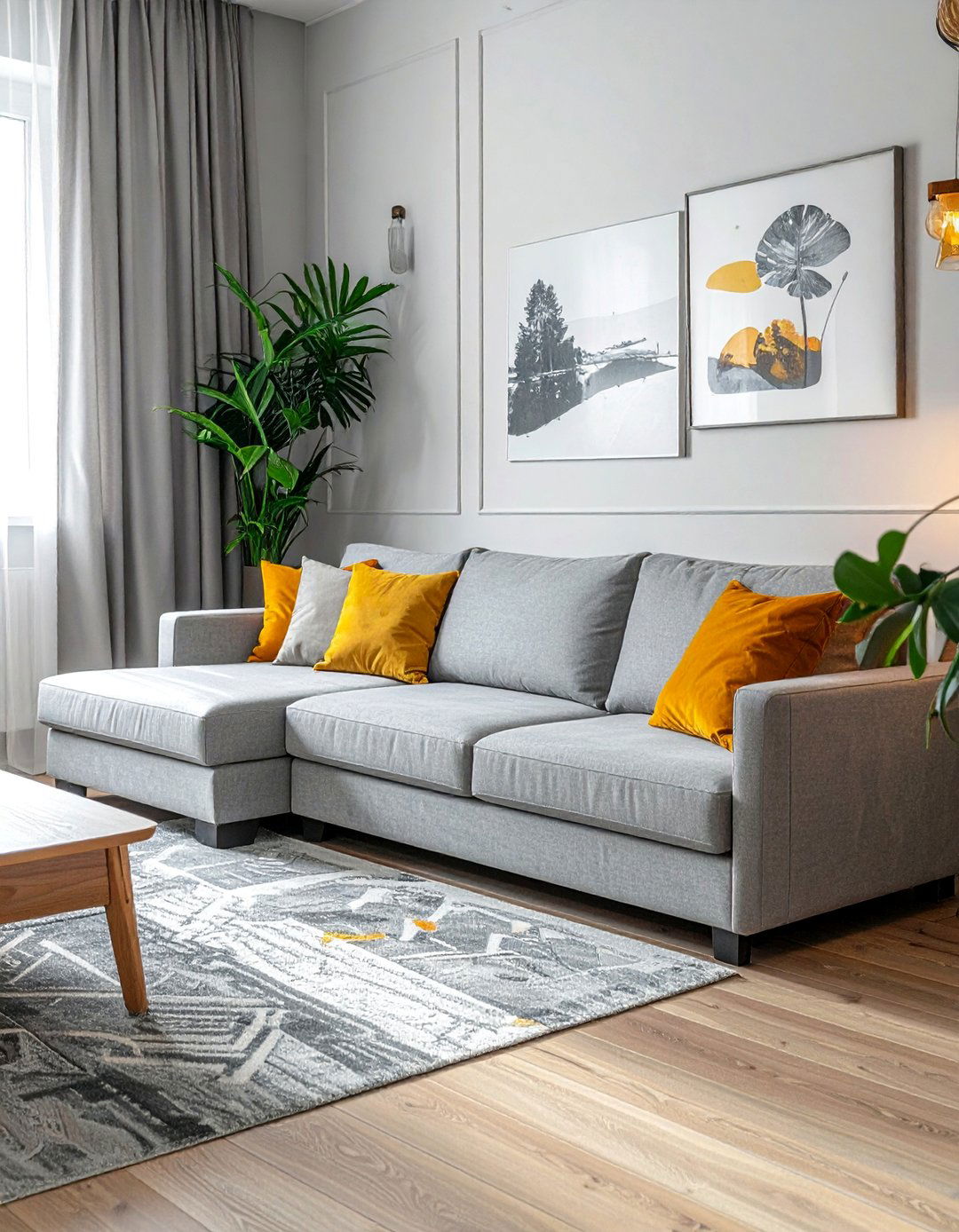
A sectional sofa might seem counterintuitive for a small living room, but a carefully chosen one can actually maximize seating and define the space efficiently. Opt for a compact, apartment-sized sectional with clean lines and a low profile. Pushing it into a corner utilizes an often-underused area and frees up central floor space, creating a cozy and designated lounge zone. This provides more seating than a separate sofa and chairs might, all while maintaining a streamlined look. Choose a model with built-in storage underneath to further enhance its functionality in a compact environment, keeping clutter at bay and maintaining order.
6. Small Living Room with Nesting Tables
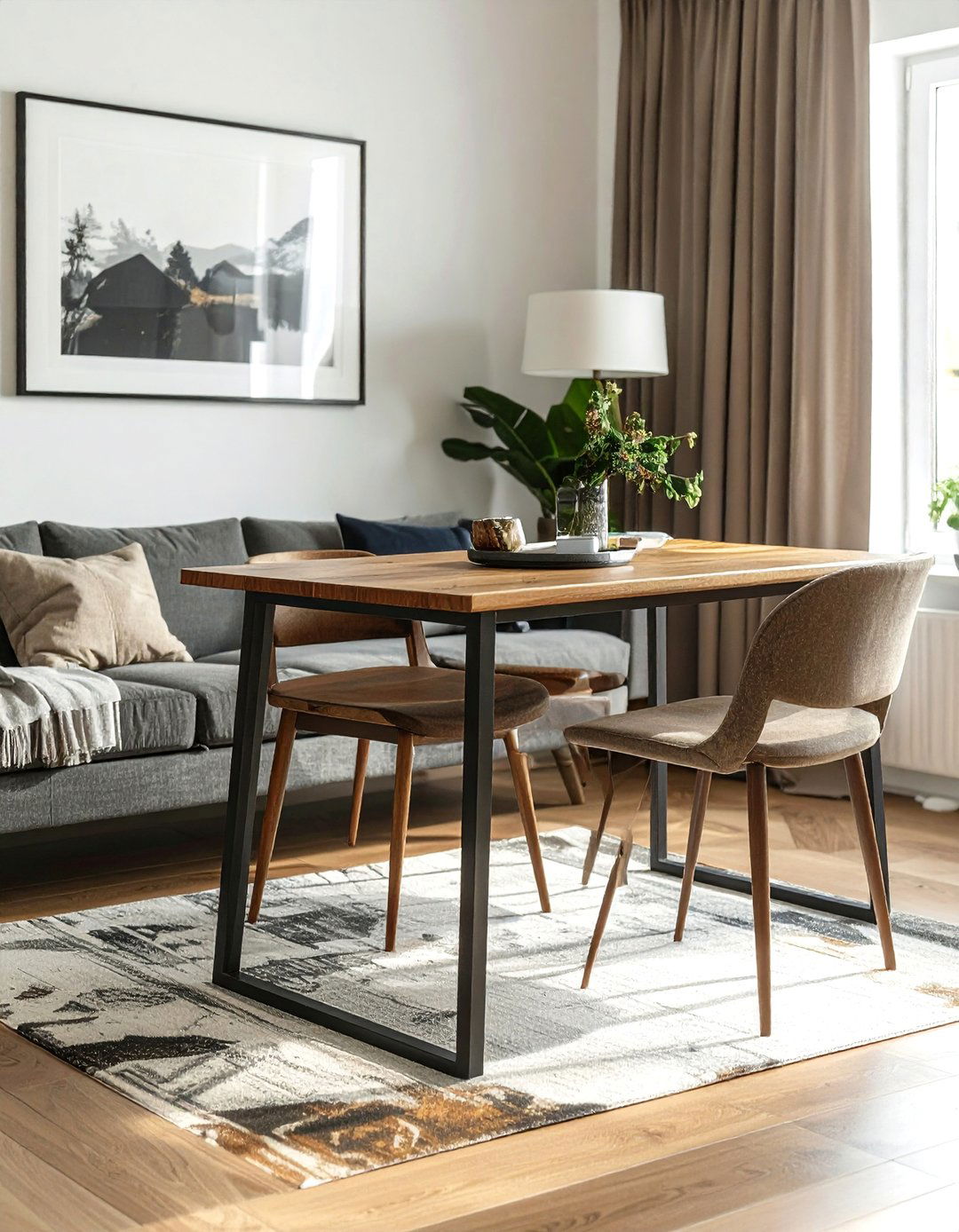
Nesting tables are a brilliant, space-saving solution for a small living room. This set of tables, typically two or three in varying sizes, can be stacked together to occupy the footprint of a single table when not in use. When you have guests, you can easily pull them apart to provide extra surface area for drinks, snacks, or books. Their versatility allows them to function as a coffee table, side tables, or even temporary stools. This adaptability makes them perfect for compact spaces where every piece of furniture needs to be multi-functional, offering flexibility without sacrificing style or creating a cluttered feel.
7. Small Living Room with Wall-Mounted Lighting
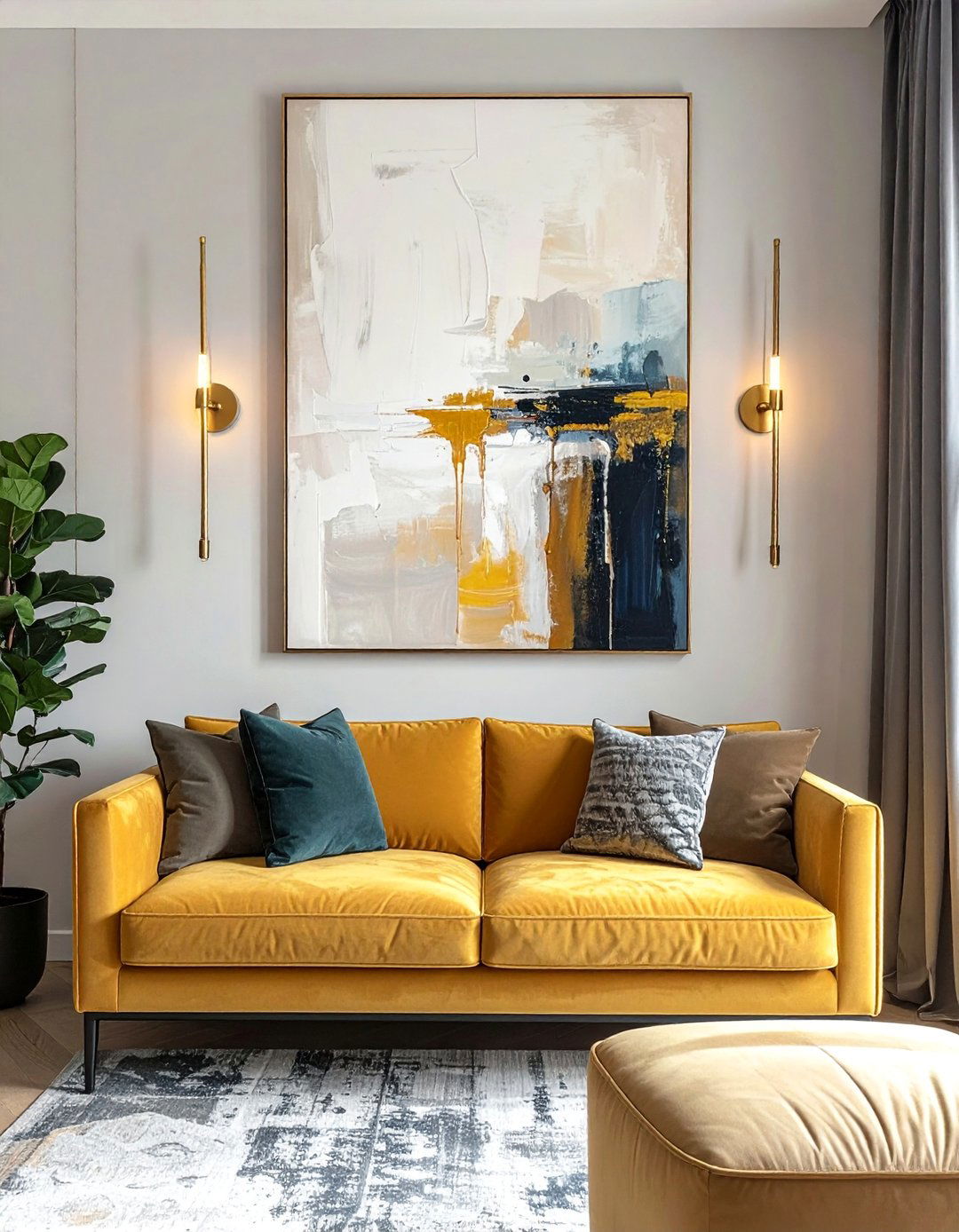
Freeing up floor and table space is crucial in a small living room, and wall-mounted lighting is an elegant way to achieve this. Sconces eliminate the need for bulky floor lamps or table lamps, which can clutter surfaces and make the room feel cramped. Installing them on either side of a sofa, a piece of art, or a mirror adds a touch of symmetry and sophistication. Choose adjustable swing-arm sconces for targeted task lighting for reading or ambient uplighting to create a warm, inviting glow. This strategy not only saves space but also adds a layer of layered lighting, enhancing the room's ambiance.
8. Small Living Room with a Light Color Palette
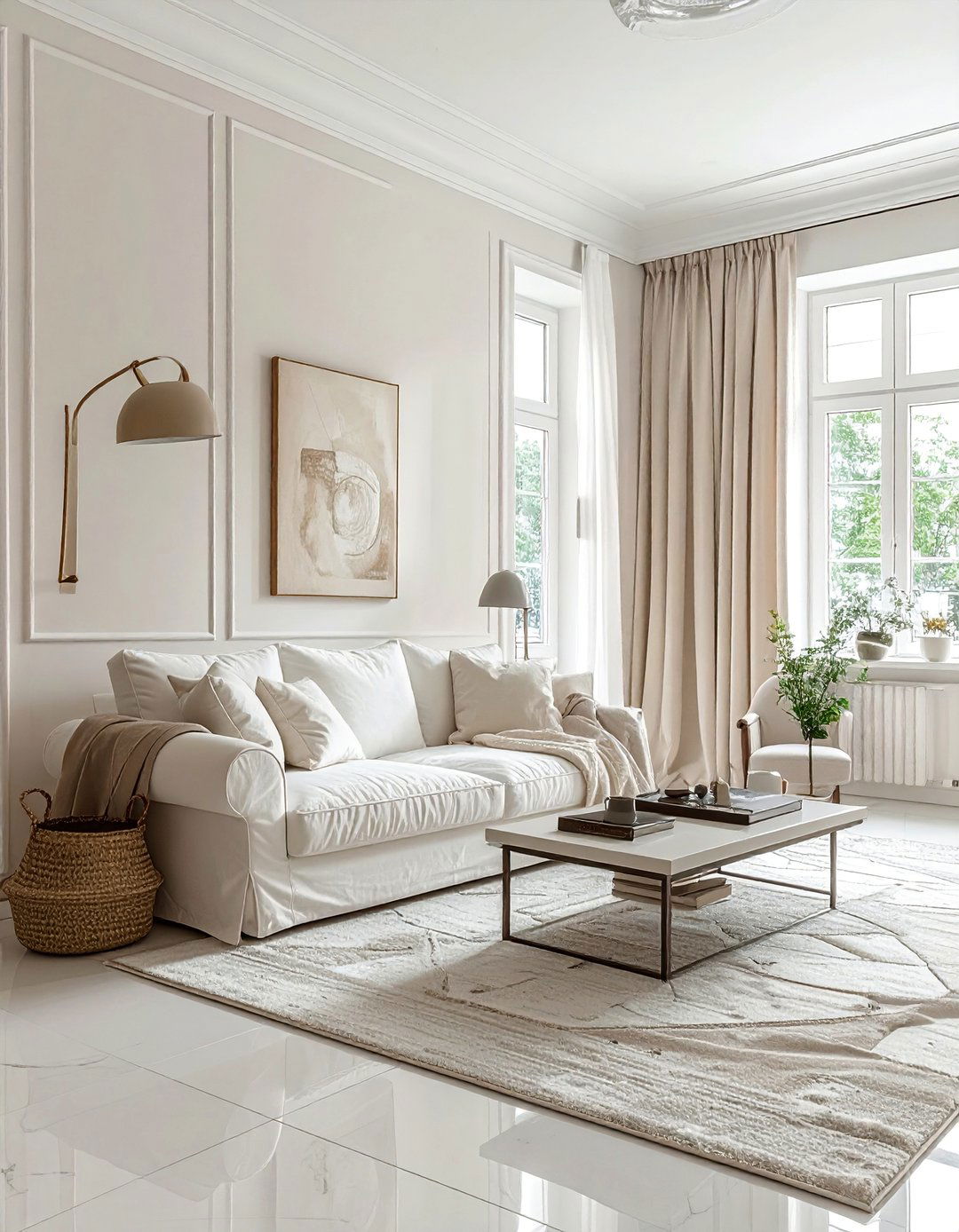
A light color palette is one of the most effective tools for making a small living room feel airy and spacious. Soft hues like white, cream, pale gray, and pastels reflect light, creating a bright and open atmosphere. Painting the walls and ceiling the same light color can blur the boundaries of the room, making it feel taller and wider. You can introduce pops of color through accessories like cushions, throws, and artwork to add personality and prevent the space from feeling sterile. This neutral backdrop provides a versatile foundation that allows your furniture and decor to stand out without overwhelming the compact dimensions.
9. Small Living Room with Vertical Stripes
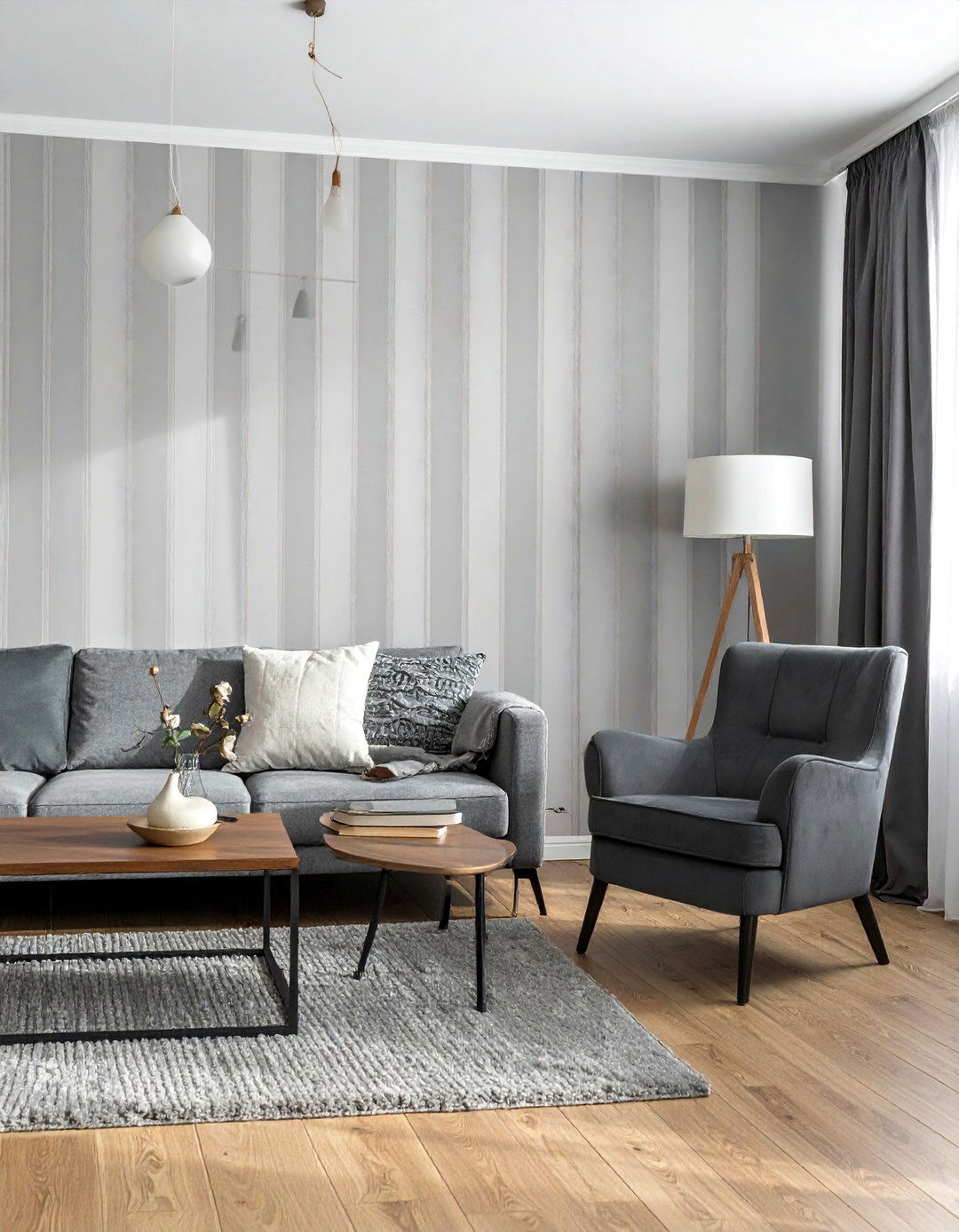
Using vertical stripes in a small living room is a clever design trick to create the illusion of height. Whether on an accent wall through wallpaper or paint, or incorporated into curtains, vertical lines draw the eye upward, making the ceiling appear higher than it is. This visual elongation helps to counteract the cramped feeling that can come with low ceilings. For a subtle effect, opt for tone-on-tone stripes. For a bolder statement, choose contrasting colors that complement your overall decor scheme. This simple yet impactful pattern can dramatically alter the perceived proportions of your space, making it feel more grand.
10. Small Living Room with See-Through Furniture
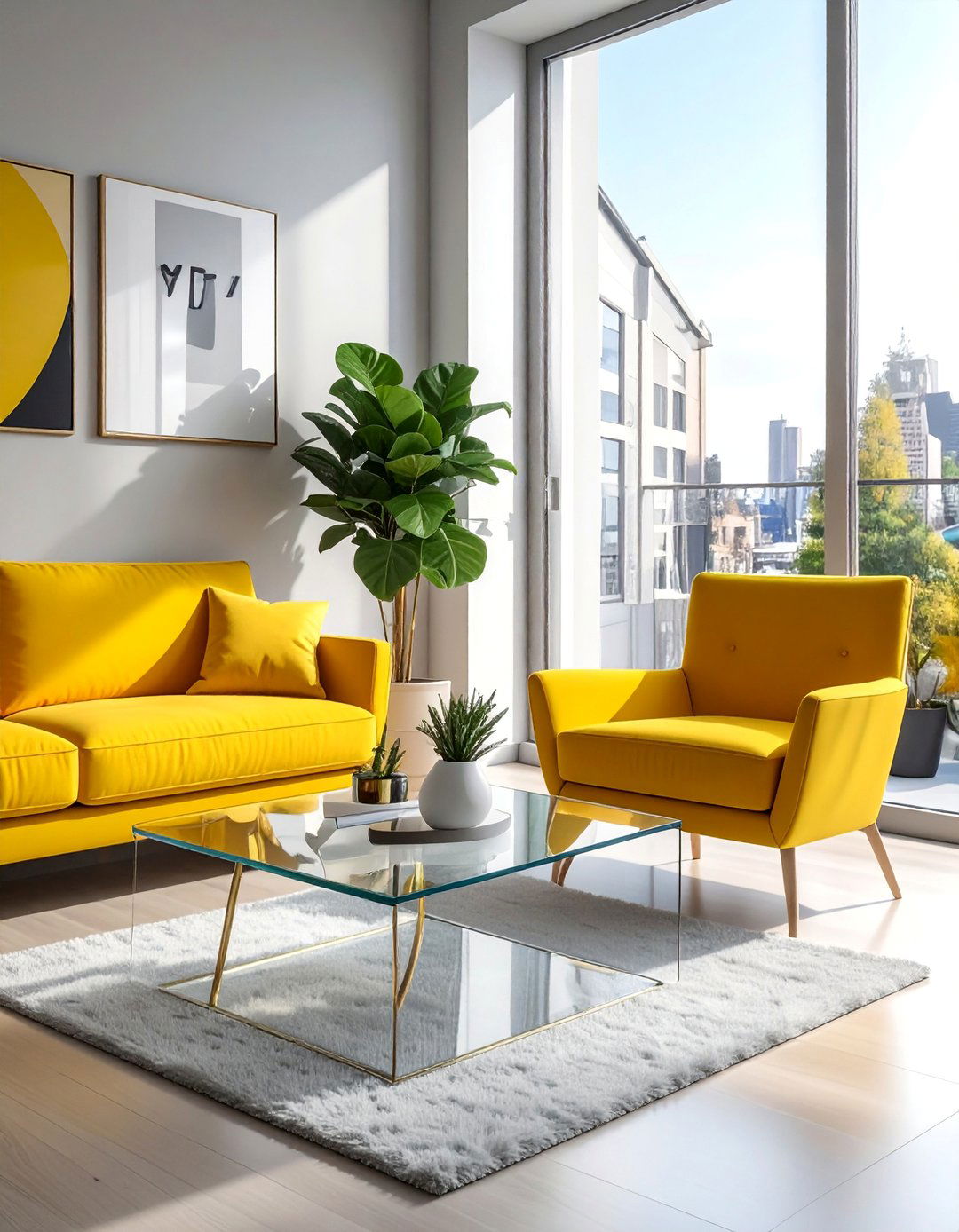
Furniture made from transparent materials like acrylic or glass is a superb choice for a small living room. Pieces such as a ghost chair, an acrylic coffee table, or a glass console table take up minimal visual space, allowing you to see through them to the floor or wall beyond. This transparency creates an unobstructed view, making the room feel less cluttered and more open. These items provide the necessary function without adding visual bulk, blending seamlessly into any decor style. This "disappearing" act is perfect for maintaining a light, airy aesthetic while still having all the essential furniture you need.
11. Small Living Room with a Multifunctional Ottoman
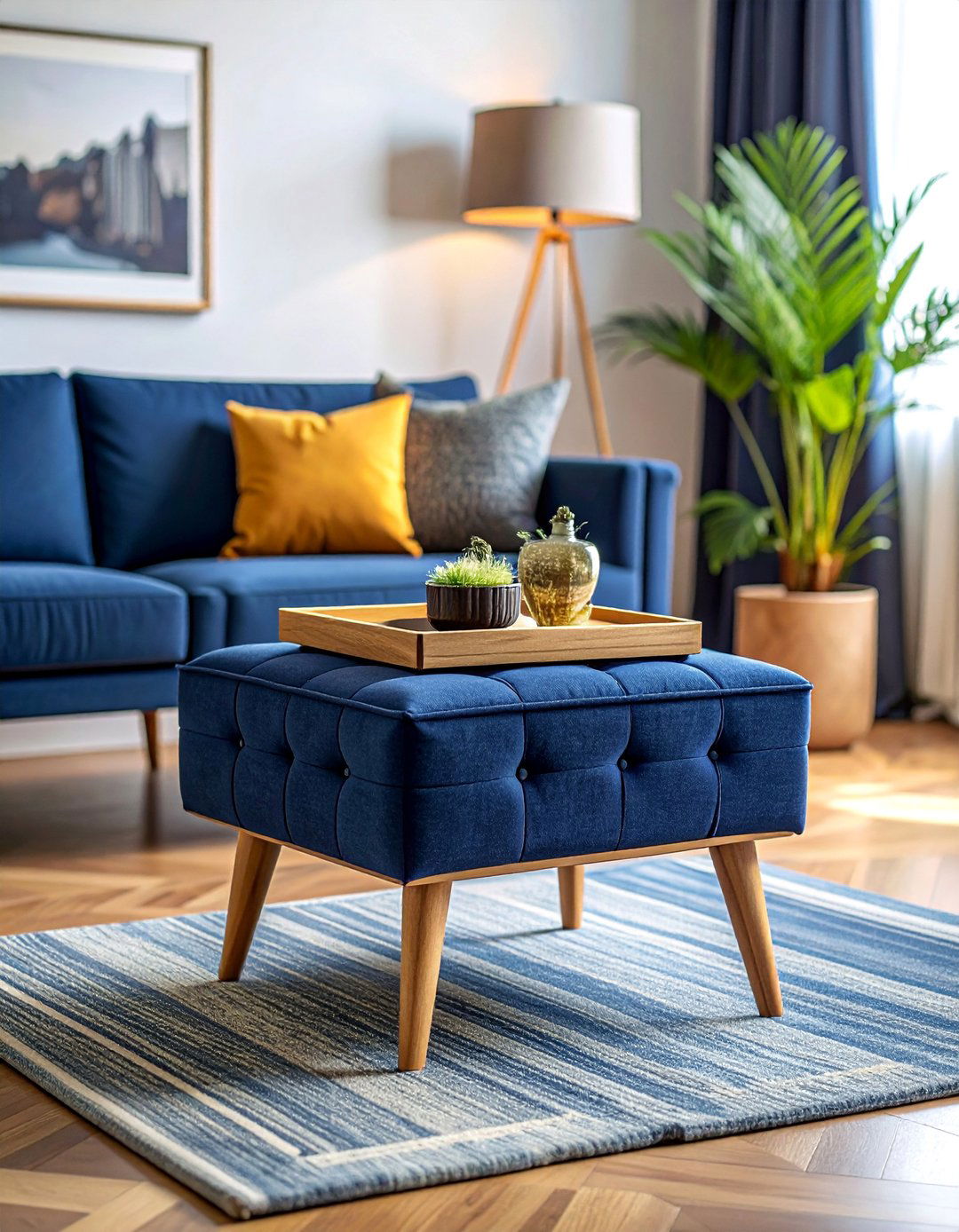
A multifunctional ottoman is a hardworking hero in a small living room. This versatile piece can serve as a coffee table (with the addition of a tray), extra seating for guests, or a comfortable footrest. Many ottomans also come with hidden storage inside, providing a discreet place to stash blankets, magazines, or remote controls, helping to keep the room tidy and organized. Choosing a storage ottoman means you can reduce the number of furniture pieces needed, which is essential for maximizing space. It's a practical, stylish, and efficient solution that adapts to your changing needs in a compact living area.
12. Small Living Room with Floor-to-Ceiling Curtains
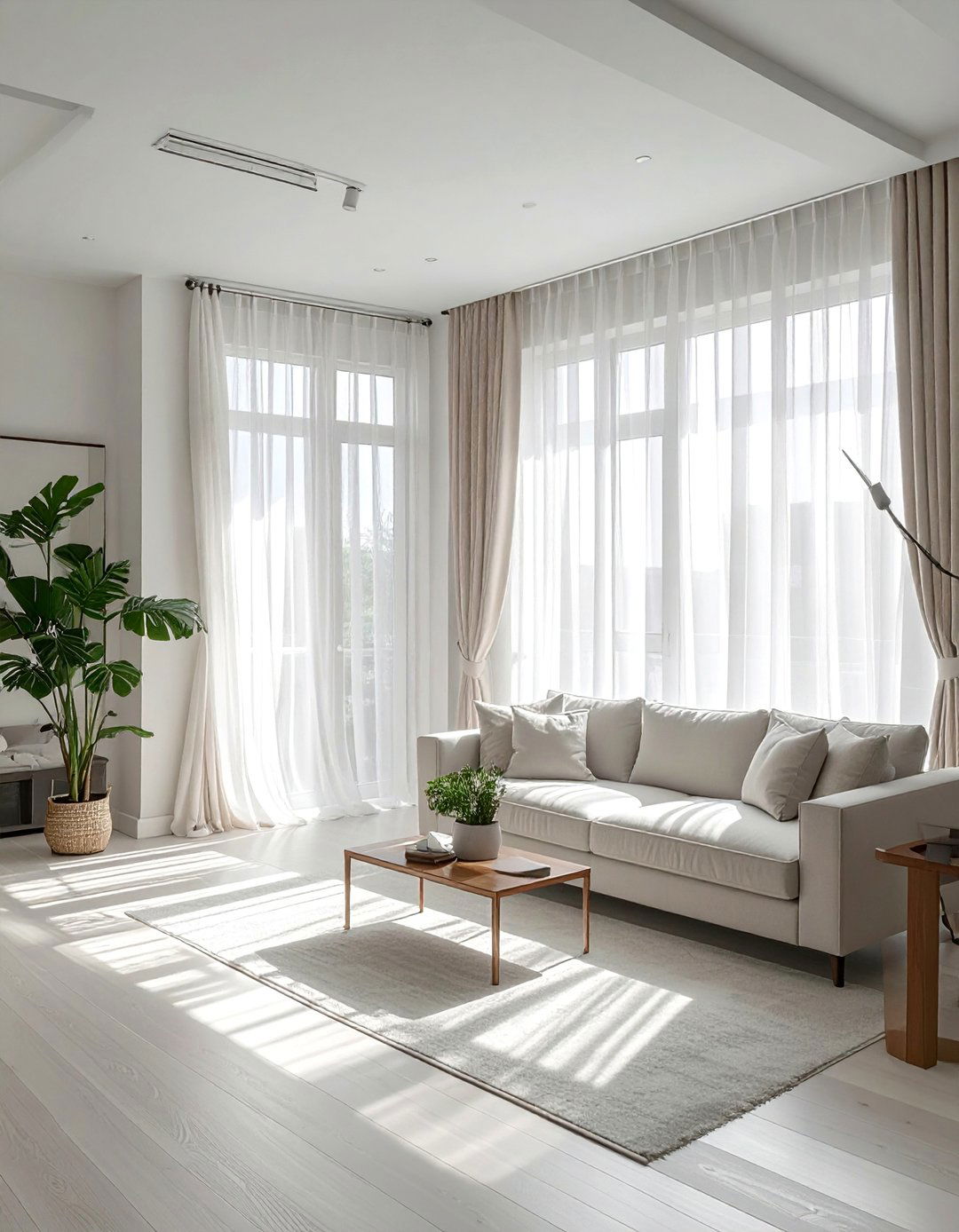
Hanging curtains high and wide is a simple yet transformative trick for any small living room. Mount the curtain rod as close to the ceiling as possible and extend it several inches beyond the window frame on each side. This technique creates the illusion of taller ceilings and wider windows, making the entire room feel more spacious and grand. Opt for lightweight, light-colored fabrics that allow natural light to filter through, further enhancing the airy feel. When the curtains are drawn open, they will frame the window beautifully without blocking precious sunlight, maximizing both light and perceived space.
13. Small Living Room with a Slim Profile Sofa
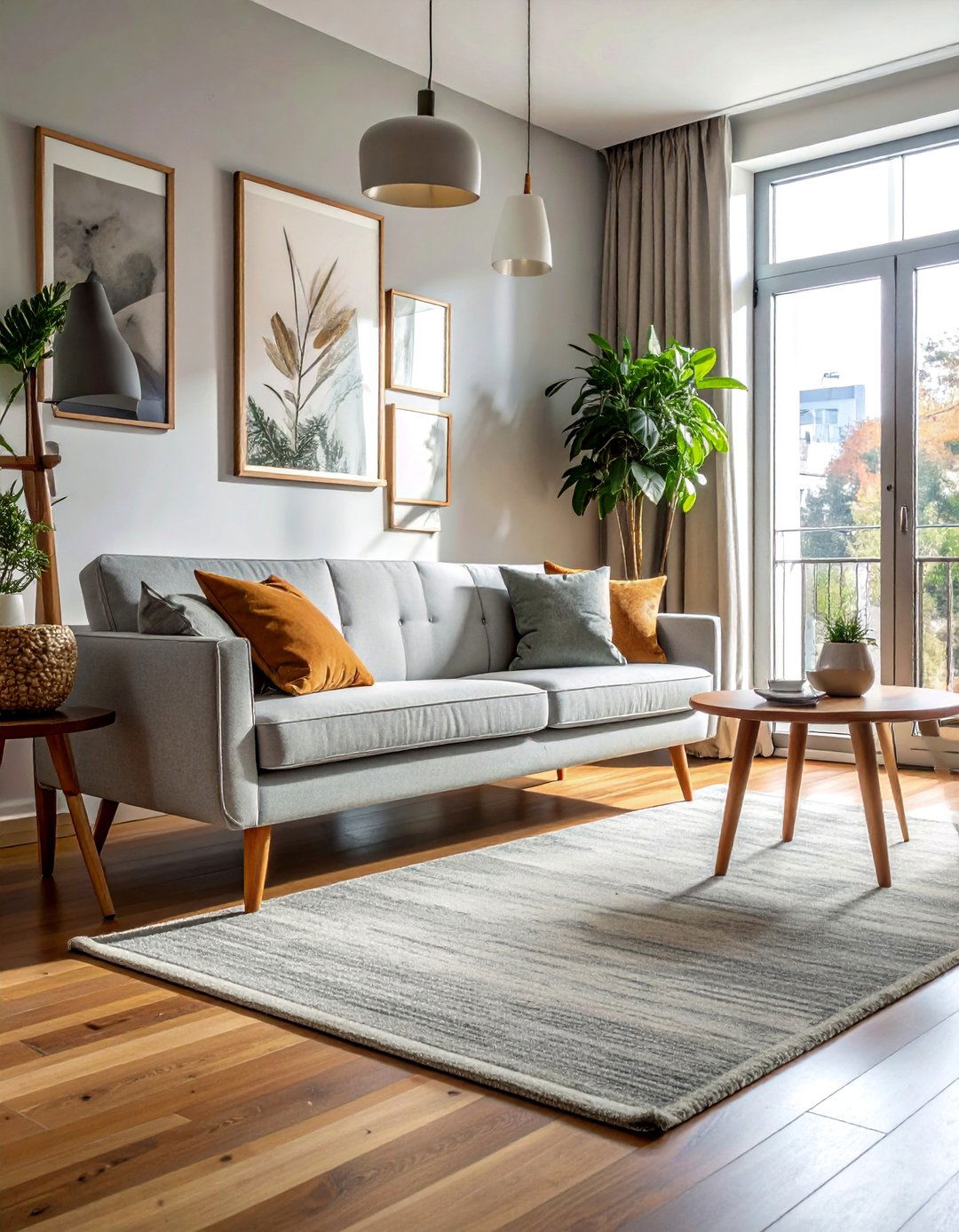
In a small living room, the sofa is often the largest piece of furniture, so choosing the right one is critical. A slim profile sofa, characterized by clean lines, slender arms, and raised legs, is an ideal choice. Sofas with exposed legs create a sense of openness by allowing you to see the floor underneath, which prevents the piece from feeling heavy or bulky. Avoid overstuffed, rolled-arm designs that consume valuable space. A streamlined, modern silhouette provides ample seating without overwhelming the room's proportions, contributing to a more balanced and uncluttered aesthetic that is perfect for cozy spaces.
14. Small Living Room with a Wall-Mounted TV
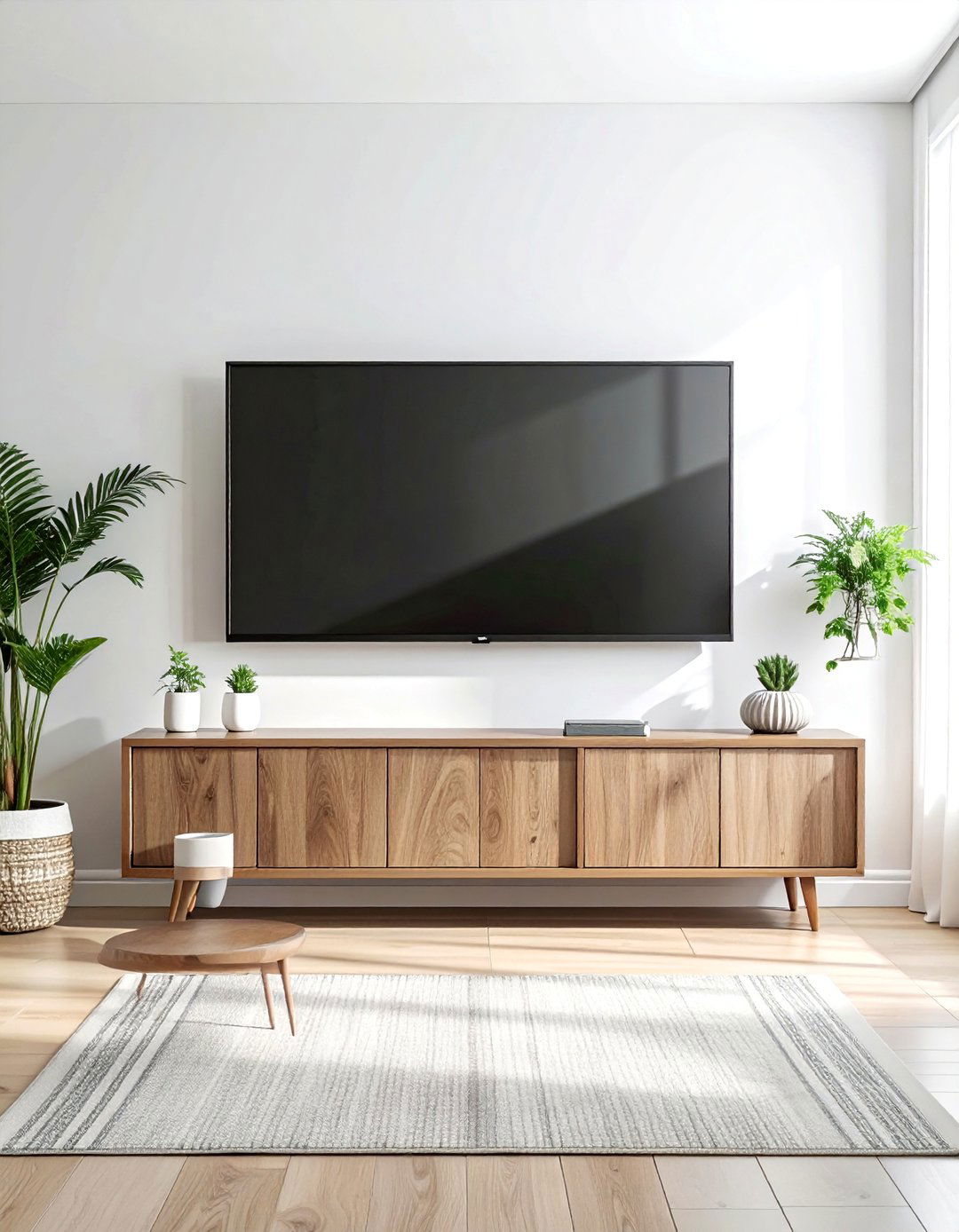
Mounting your television on the wall is a smart move in a small living room. This eliminates the need for a bulky media console or TV stand, freeing up valuable floor space that can be used for other purposes or left open to create a less cluttered look. A wall-mounted TV creates a sleek, modern aesthetic and helps to streamline the room's focal point. You can run the cables through the wall for a completely clean installation. This setup not-only saves space but also positions the screen at an optimal viewing height, improving your entertainment experience while maintaining a tidy and organized environment.
15. Small Living Room with a Cohesive Color Scheme
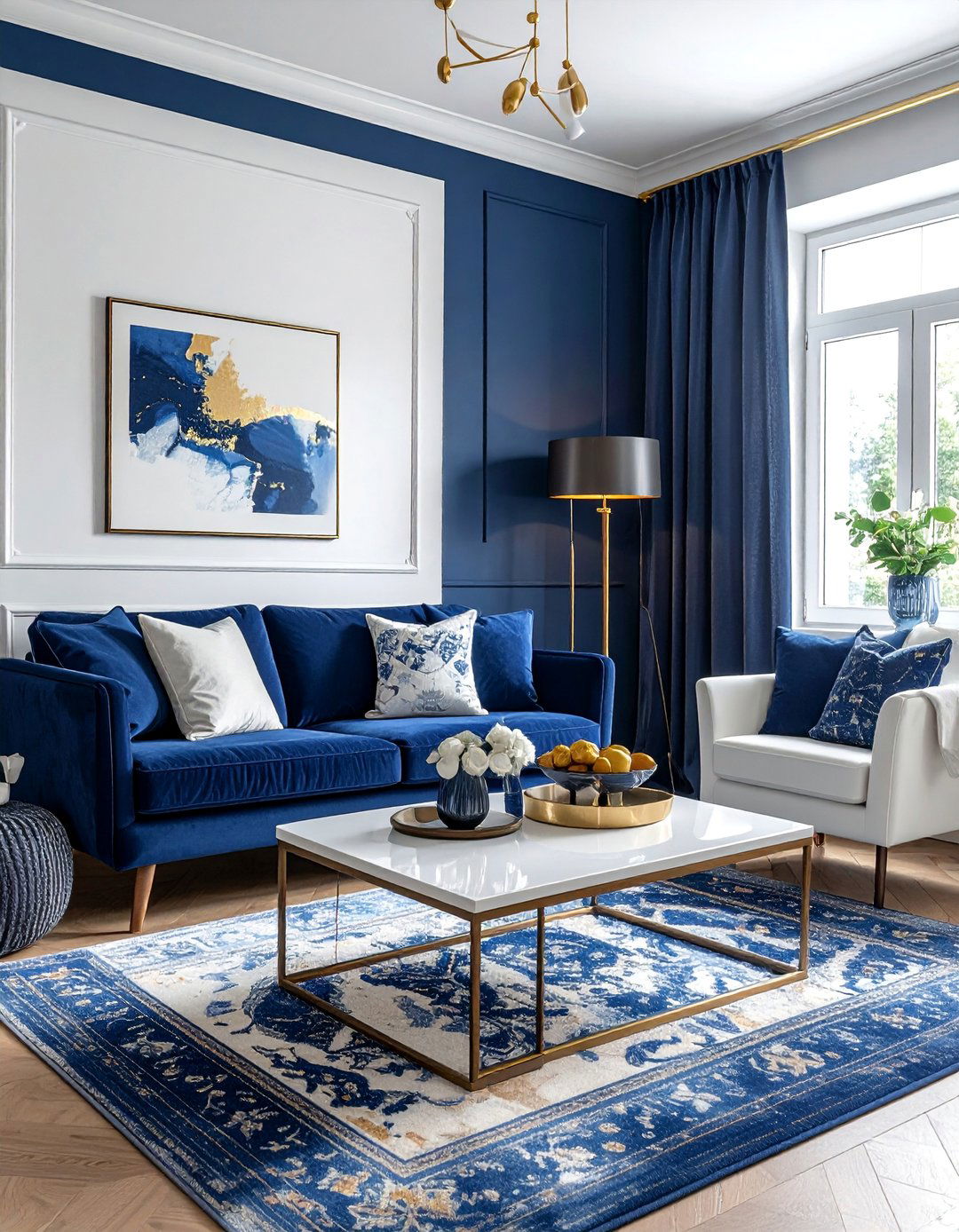
Sticking to a cohesive color scheme is essential for creating a harmonious and uncluttered look in a small living room. A limited palette of two to three complementary colors helps to unify the space and prevent it from feeling chaotic or busy. Monochromatic schemes, using different shades and tints of a single color, are particularly effective at creating a sense of calm and spaciousness. This doesn't mean the room has to be boring; you can introduce texture and subtle patterns within your chosen palette to add depth and interest. A well-planned color strategy makes the room feel intentional and visually expansive.
16. Small Living Room with Smart Storage Solutions
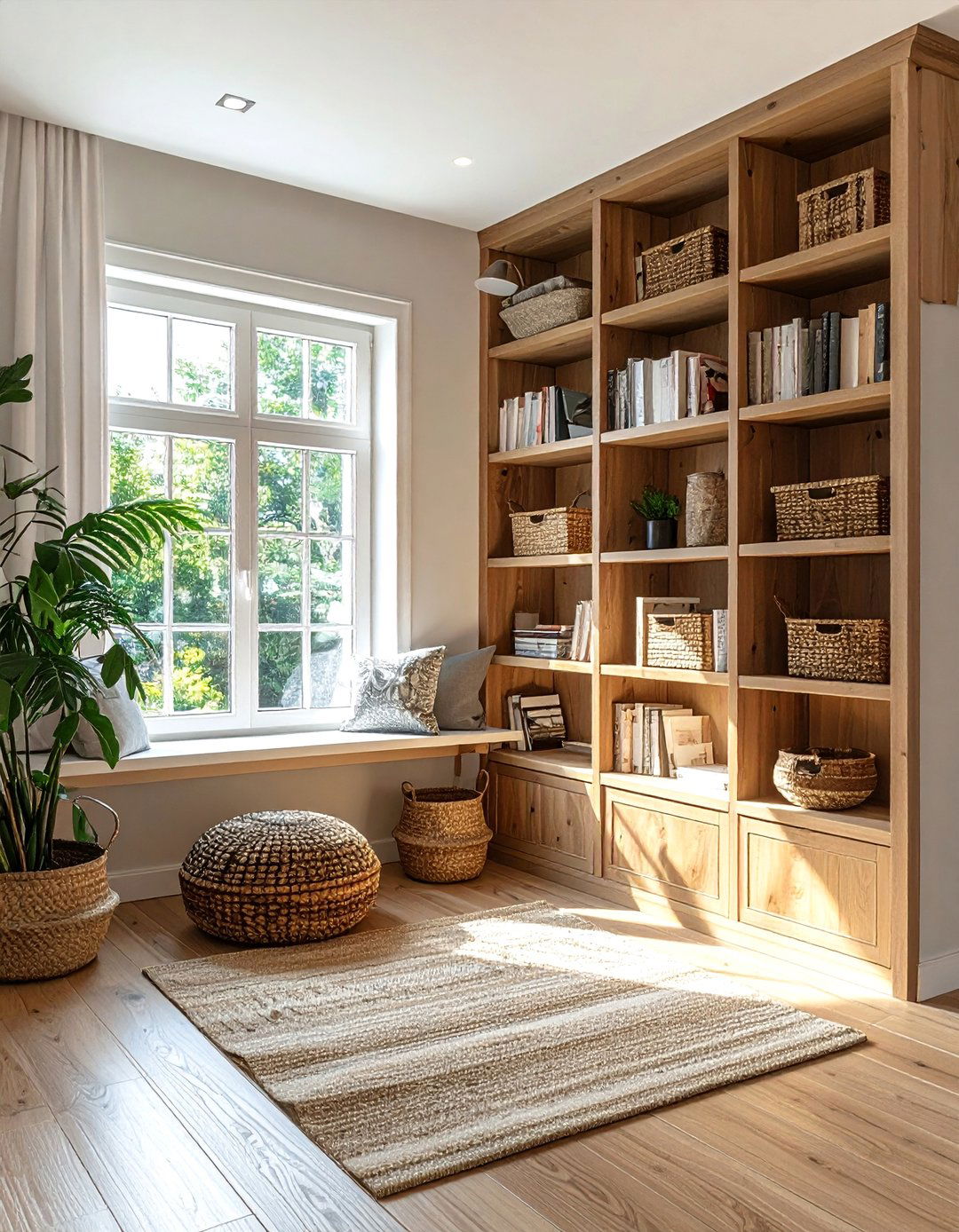
Effective storage is paramount in a small living room to keep clutter under control. Look for smart storage solutions that are integrated and discreet. Think built-in shelving that utilizes vertical space, coffee tables with drawers or lift-tops, and side tables with hidden compartments. Baskets and decorative boxes can be used to corral smaller items on open shelves or under tables, keeping them organized yet accessible. By ensuring every item has a designated place, you can maintain a tidy environment, which is crucial for making a small space feel calm, functional, and larger than it actually is.
17. Small Living Room with Scaled-Down Furniture
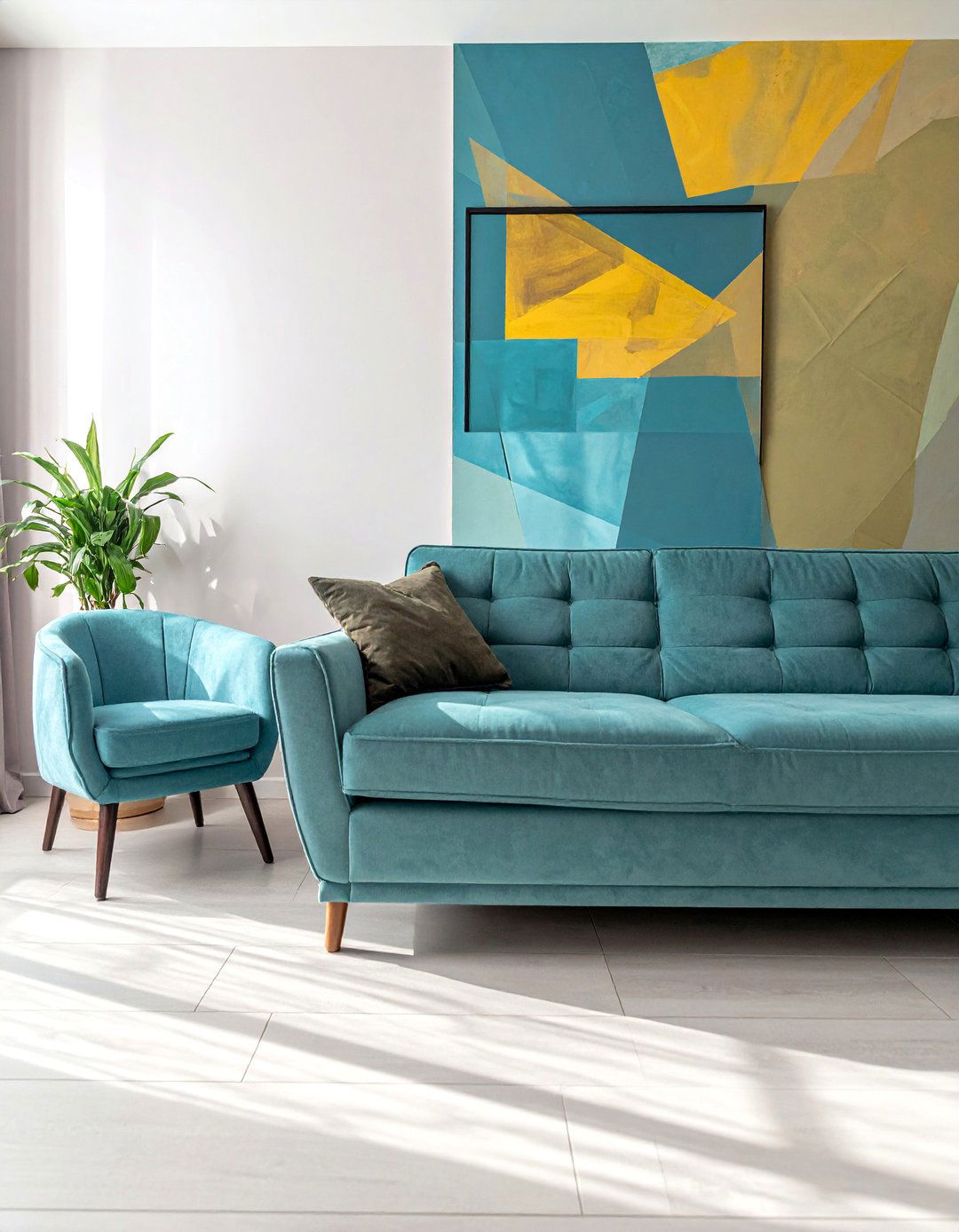
Choosing furniture that is appropriately scaled for a small living room is fundamental to its success. Avoid oversized, bulky pieces that will dominate the room and make it feel cramped. Instead, opt for "apartment-sized" furniture, which is specifically designed with smaller proportions. A loveseat can be a better choice than a full-sized sofa, and slender armchairs can provide extra seating without adding bulk. Selecting pieces with a smaller footprint ensures that you have enough room for comfortable circulation and prevents the space from feeling overstuffed, creating a more balanced and inviting atmosphere.
18. Small Living Room with an Accent Wall
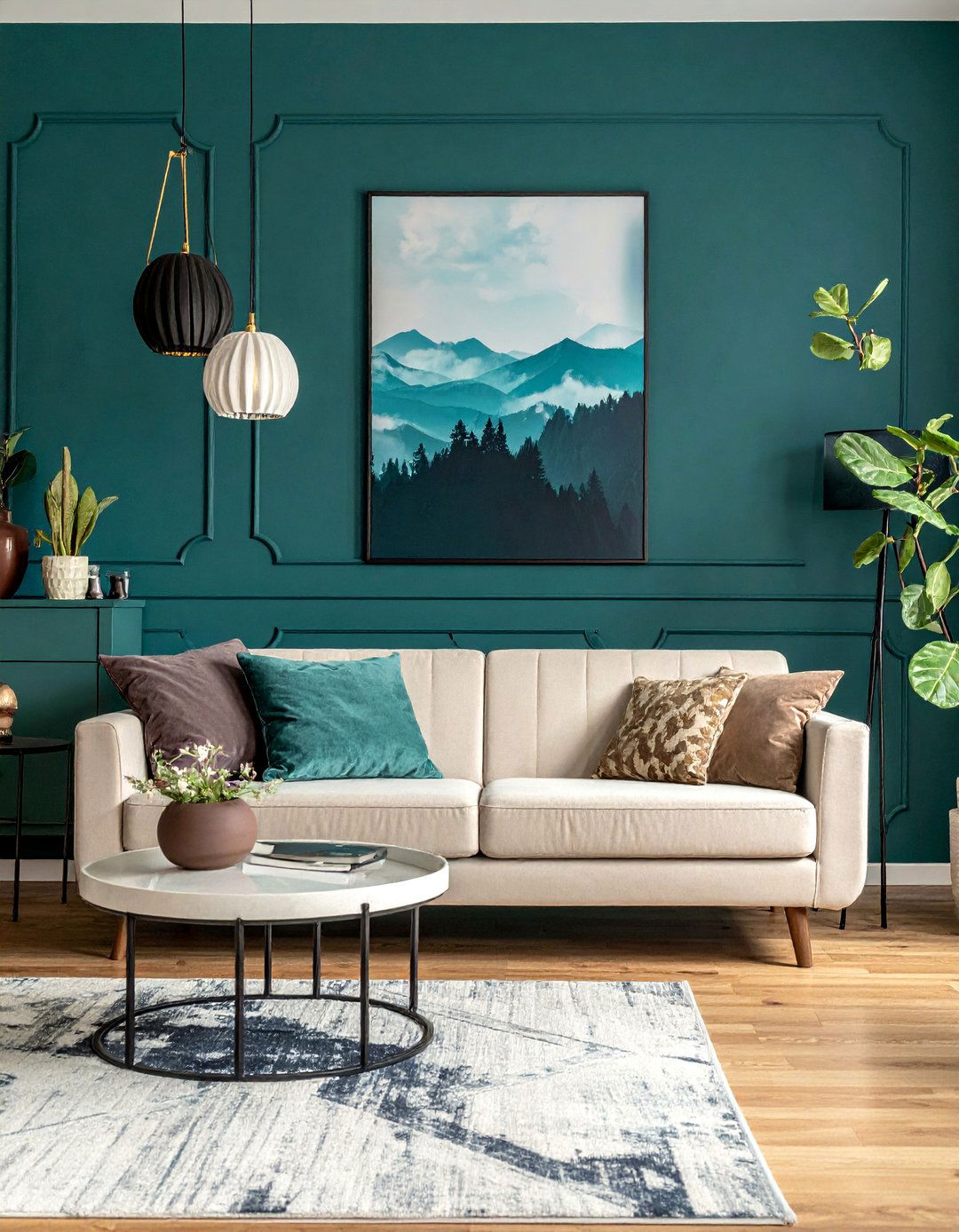
Creating an accent wall can add depth and personality to a small living room without overwhelming the space. By painting one wall a bold color or applying an interesting wallpaper, you can create a focal point that draws the eye and adds a sense of dimension. Typically, the best wall to accent is the one you see first when you enter the room or the one behind the sofa. This technique allows you to inject vibrant color or pattern into your decor scheme in a controlled way, making a strong style statement while keeping the other walls light to maintain an overall feeling of openness.
19. Small Living Room with Abundant Natural Light
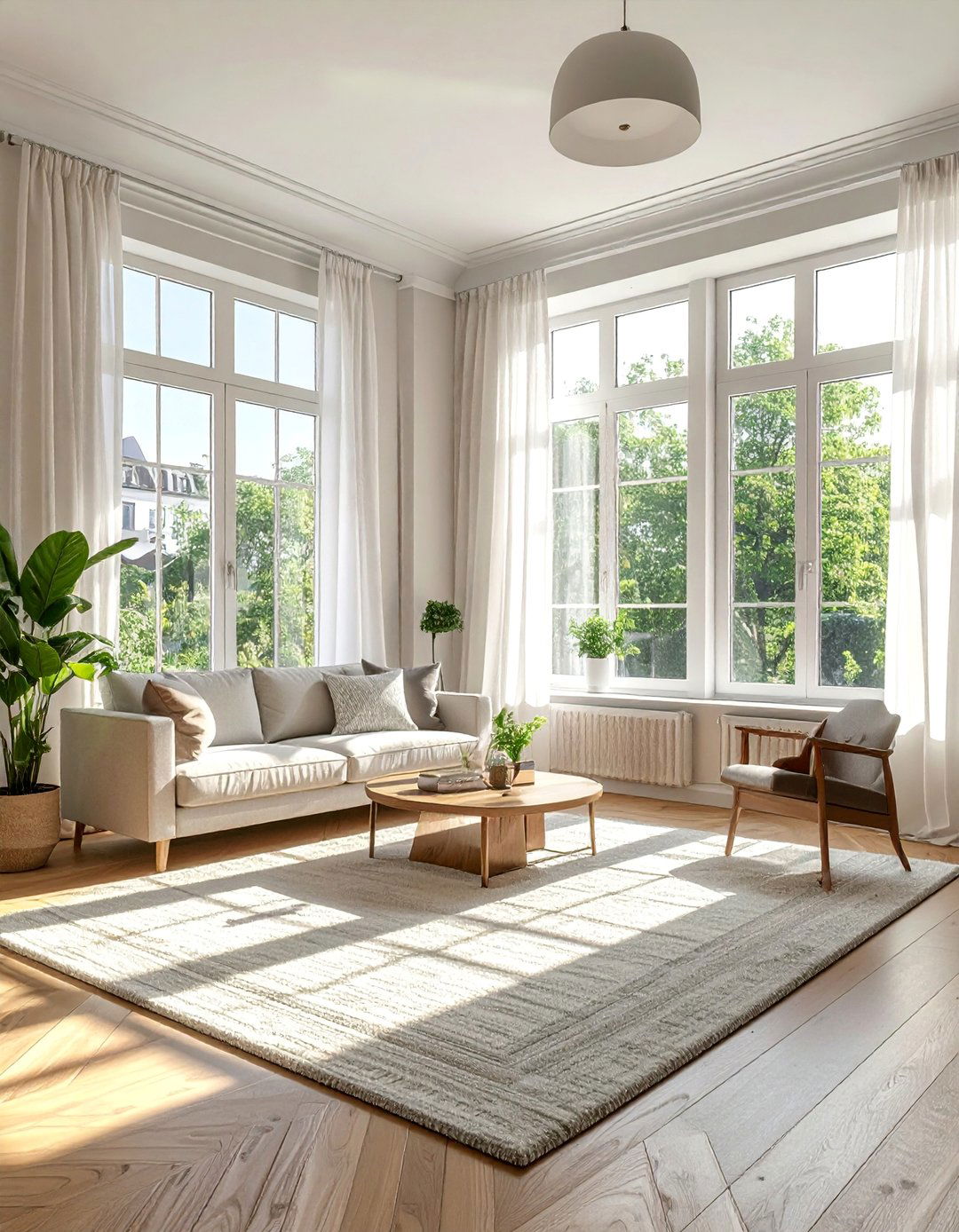
Maximizing natural light is one of the most powerful ways to make a small living room feel larger and more inviting. Keep window treatments minimal and sheer to allow as much daylight as possible to stream in. Avoid heavy, dark drapes that can block light and make the room feel closed-in. Strategically placing mirrors opposite windows will also help to bounce light around the room, amplifying its brightening effect. A well-lit space naturally feels more open and airy, so do everything you can to enhance the sunlight you have. Clean windows regularly to ensure an unobstructed flow of light.
20. Small Living Room with a Built-In Window Seat
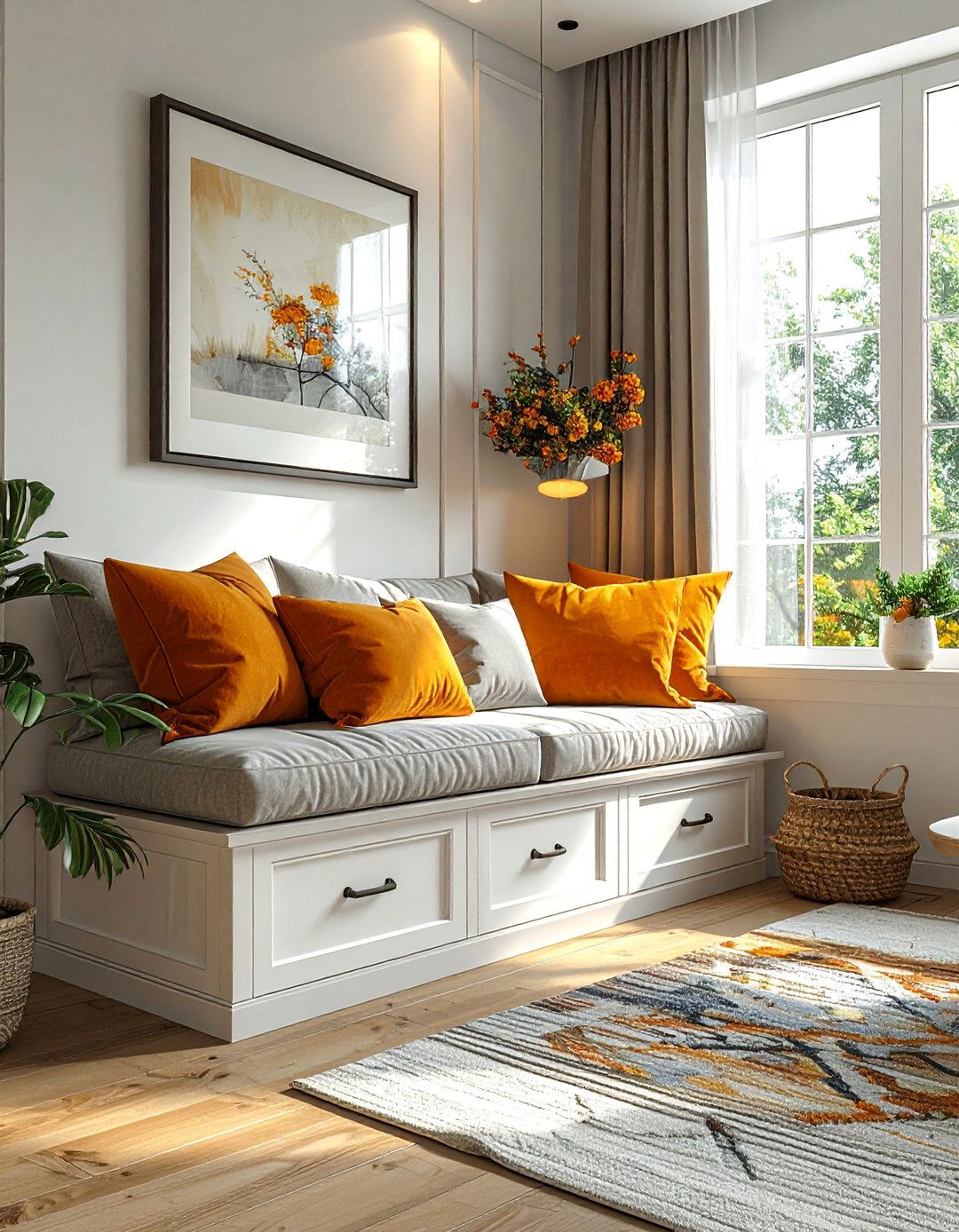
A built-in window seat is a fantastic, multi-purpose feature for a small living room. It provides comfortable seating without taking up valuable floor space in the center of the room. This cozy nook can be the perfect spot for reading or enjoying a cup of tea. Furthermore, the base of the window seat can be designed with built-in drawers or lift-top storage, offering a discreet place to store blankets, pillows, or games. It transforms an often-underutilized area into a charming and highly functional focal point, adding both character and practicality to your compact living space.
21. Small Living Room with a Corner Fireplace
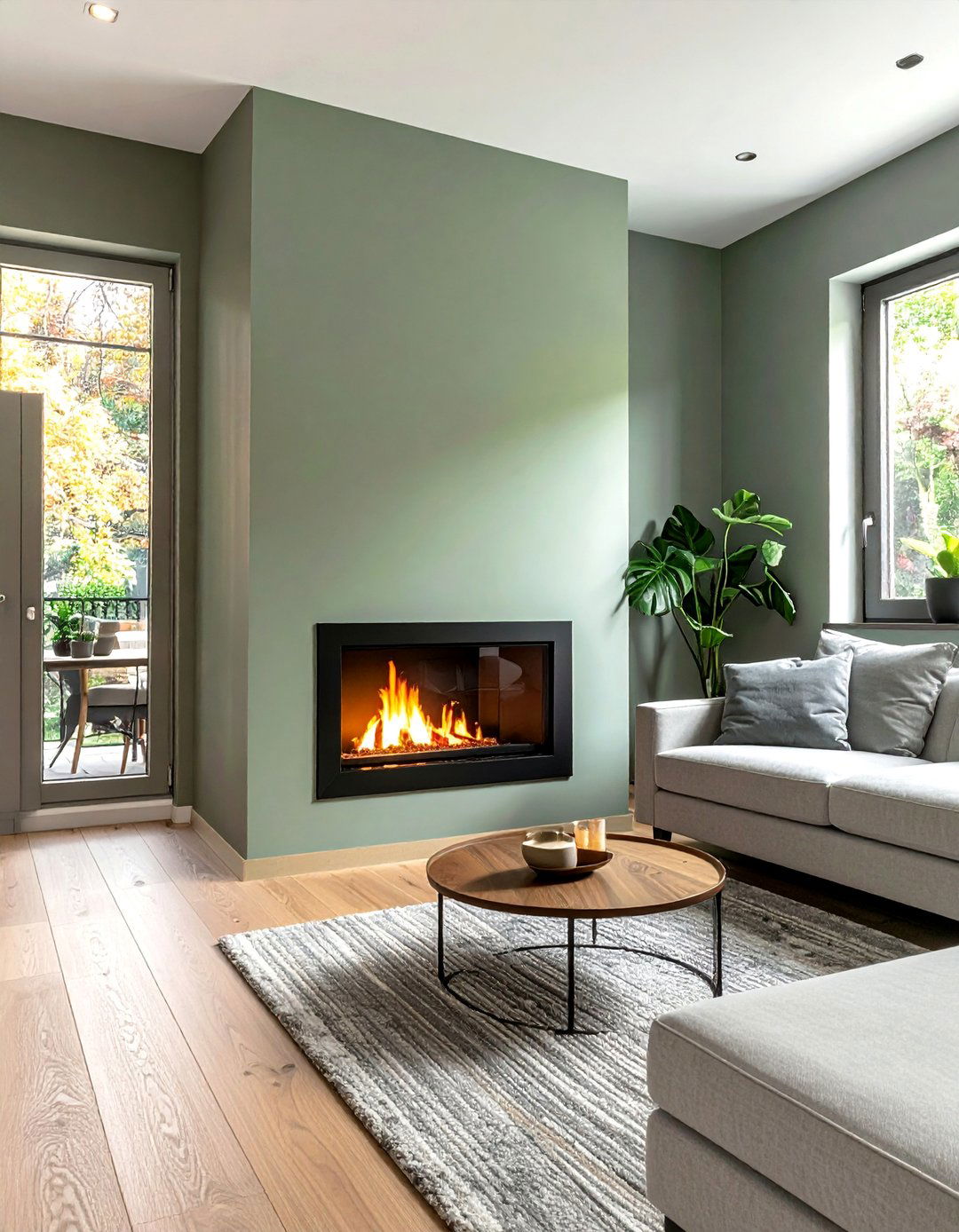
A corner fireplace can be a brilliant addition to a small living room, creating a cozy and inviting focal point without consuming a large central wall. This placement utilizes an often-awkward corner, freeing up the main walls for furniture arrangement or artwork. It anchors the room, provides a natural gathering spot, and adds architectural interest. You can arrange seating around it to foster conversation and warmth. Modern electric or gas corner fireplaces are available in various slim designs that are perfect for compact spaces, offering the ambiance of a traditional hearth with a much smaller footprint.
22. Small Living room with a Low-Profile Media Unit
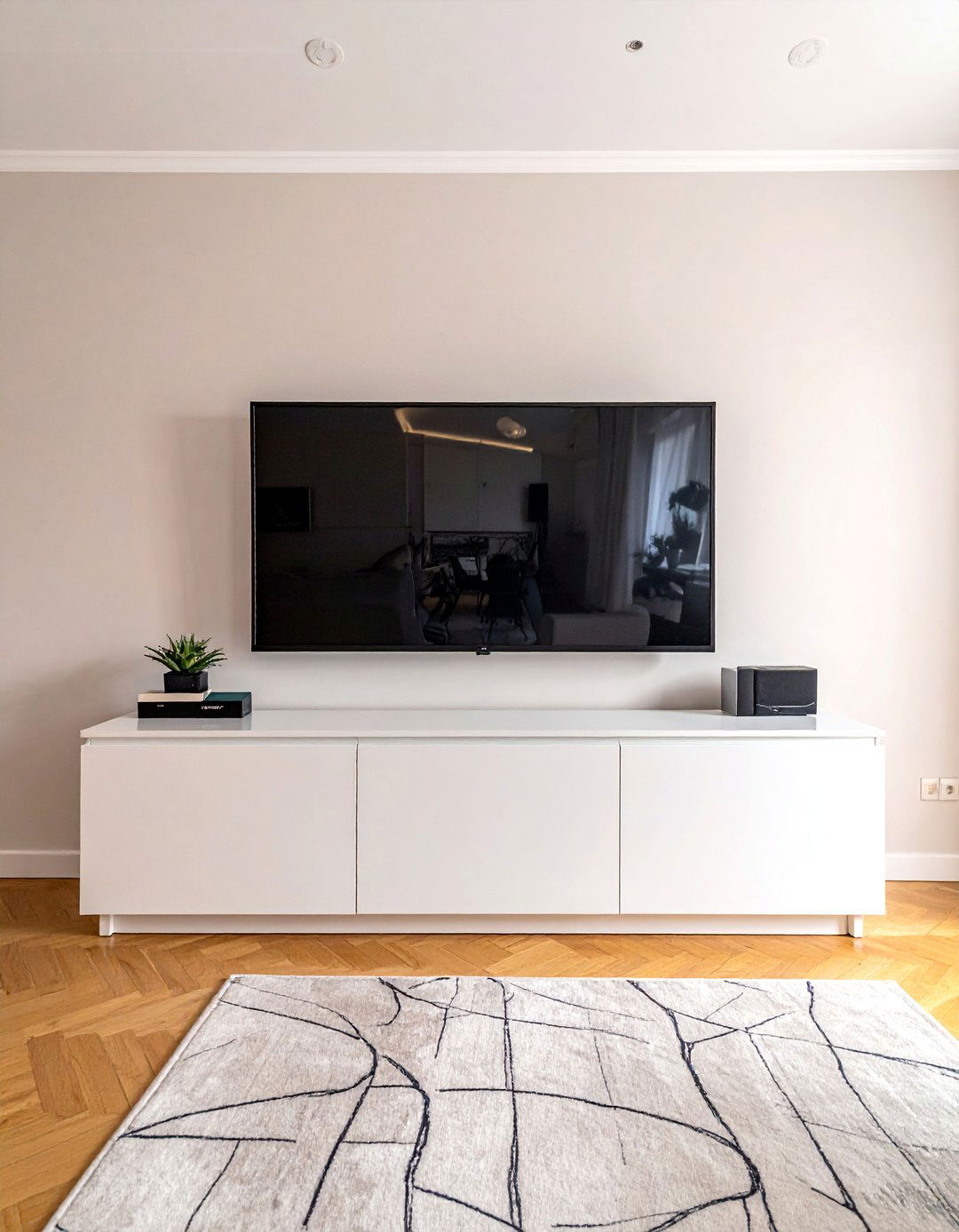
In a small living room, a low-profile media unit is a superior choice to a tall, bulky entertainment center. A long, low console keeps the sightlines open and helps the room feel less crowded. It provides a surface for your TV if you choose not to wall-mount it, along with essential storage for media devices, all while maintaining a sleek and unobtrusive presence. Look for designs with clean lines and a minimalist aesthetic. This approach keeps the focus on the upper half of the room, drawing the eye upward and contributing to an overall sense of spaciousness and modern simplicity.
23. Small Living Room with a Daybed
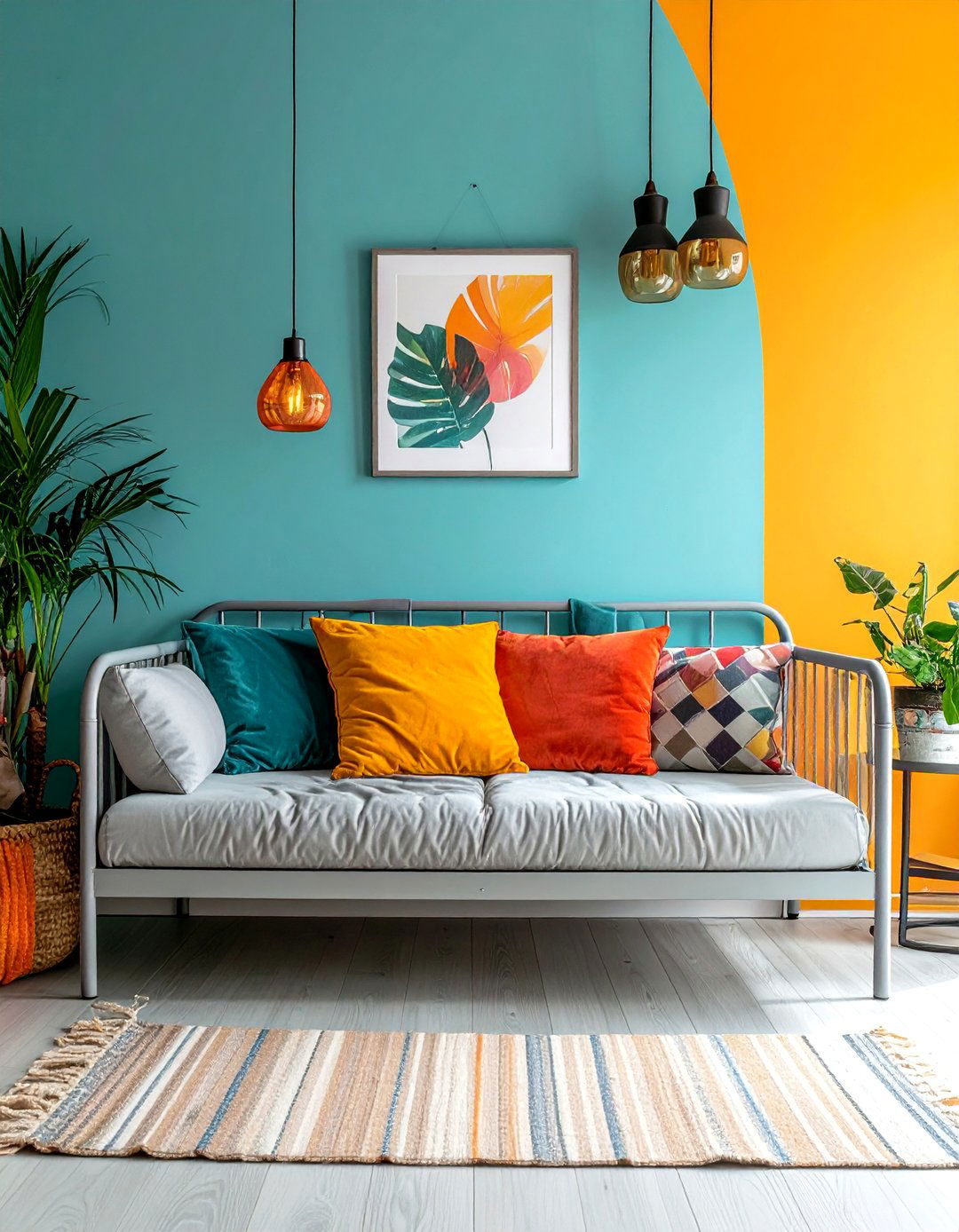
A daybed is a wonderfully versatile piece of furniture for a small living room, especially if the space needs to double as a guest room. By day, it functions as a stylish sofa, providing comfortable seating. Adorned with plush cushions and throws, it can be a chic and inviting focal point. By night, it easily transforms into a comfortable bed for an overnight guest. This two-in-one functionality eliminates the need for a separate sofa and guest bed, saving an incredible amount of space. Its typically streamlined design fits well within compact areas, making it a practical and elegant solution.
24. Small Living Room with a Monochromatic Scheme

A monochromatic color scheme, which uses various tones, shades, and tints of a single color, is a sophisticated strategy for a small living room. This approach creates a seamless and cohesive look that can make the space feel larger and more serene. By minimizing sharp visual contrasts, the eye flows smoothly around the room, blurring the boundaries and creating an illusion of spaciousness. To prevent the look from becoming flat, incorporate a variety of textures through fabrics like velvet, linen, and chunky knits, as well as materials like wood and metal. This adds depth and interest while maintaining a calming, unified aesthetic.
25. Small Living Room with Strategic Art Placement
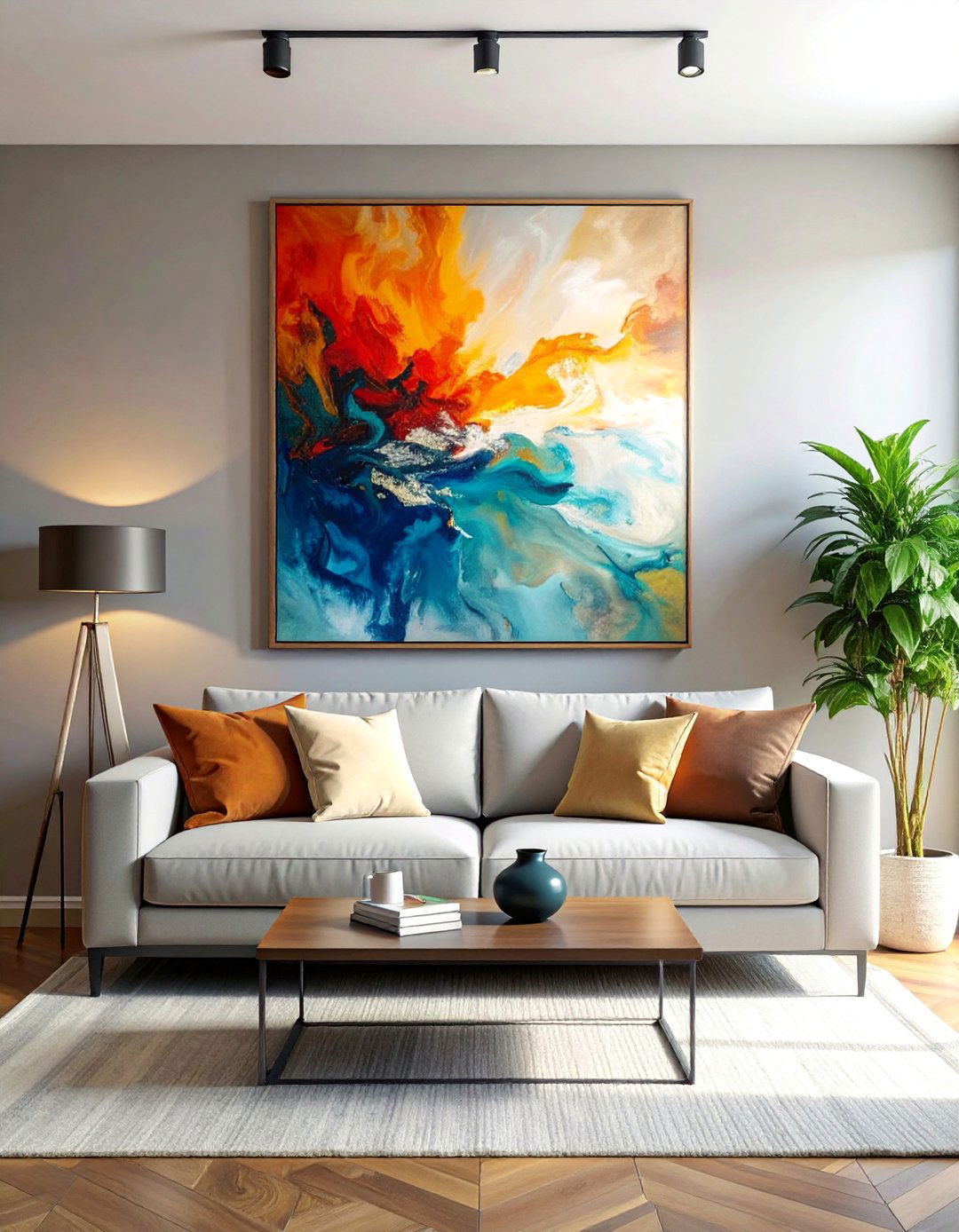
The way you display art in a small living room can significantly impact its perceived size. Instead of scattering many small pieces, consider hanging one large, statement piece of artwork. A single, oversized piece can act as a powerful focal point and make the wall feel bigger. Alternatively, a tightly curated gallery wall can also work well if the frames are cohesive and the arrangement is well-planned. Hanging art slightly higher than eye level can also draw the eye upward, creating a sense of height. Strategic art placement adds personality and style without contributing to visual clutter.
26. Small Living Room with Leggy Furniture
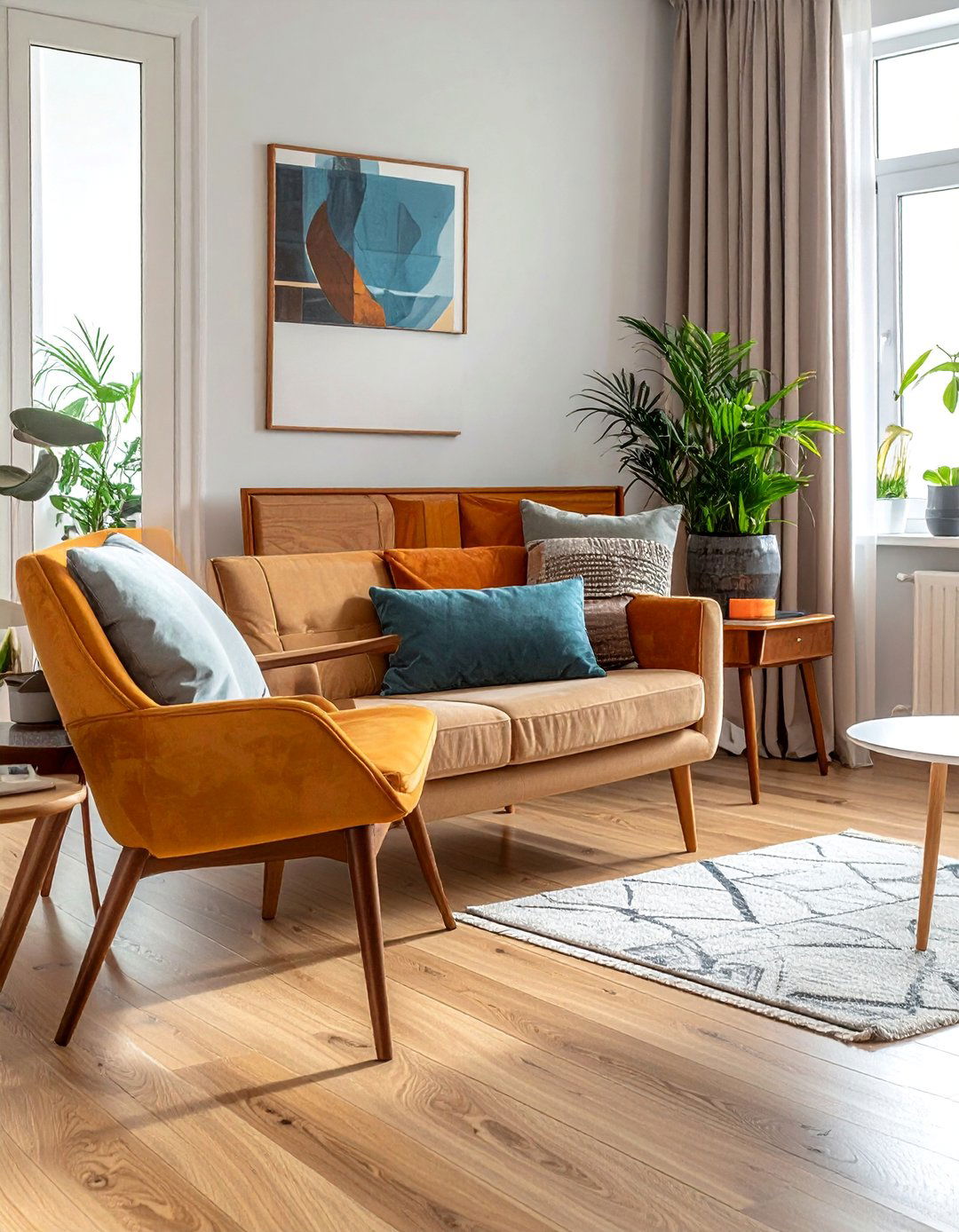
Choosing furniture with exposed legs, often referred to as "leggy" furniture, is a key strategy for creating a sense of spaciousness in a small living room. Sofas, armchairs, coffee tables, and sideboards that are raised off the ground allow you to see more of the floor. This visual trick makes the room feel lighter, airier, and less cluttered. The open space underneath the furniture prevents it from appearing heavy and bulky, which can weigh down a compact room. This mid-century modern-inspired design principle is both stylish and highly effective in maximizing the perception of space.
27. Small Living Room with a Pull-Out Sofa Bed
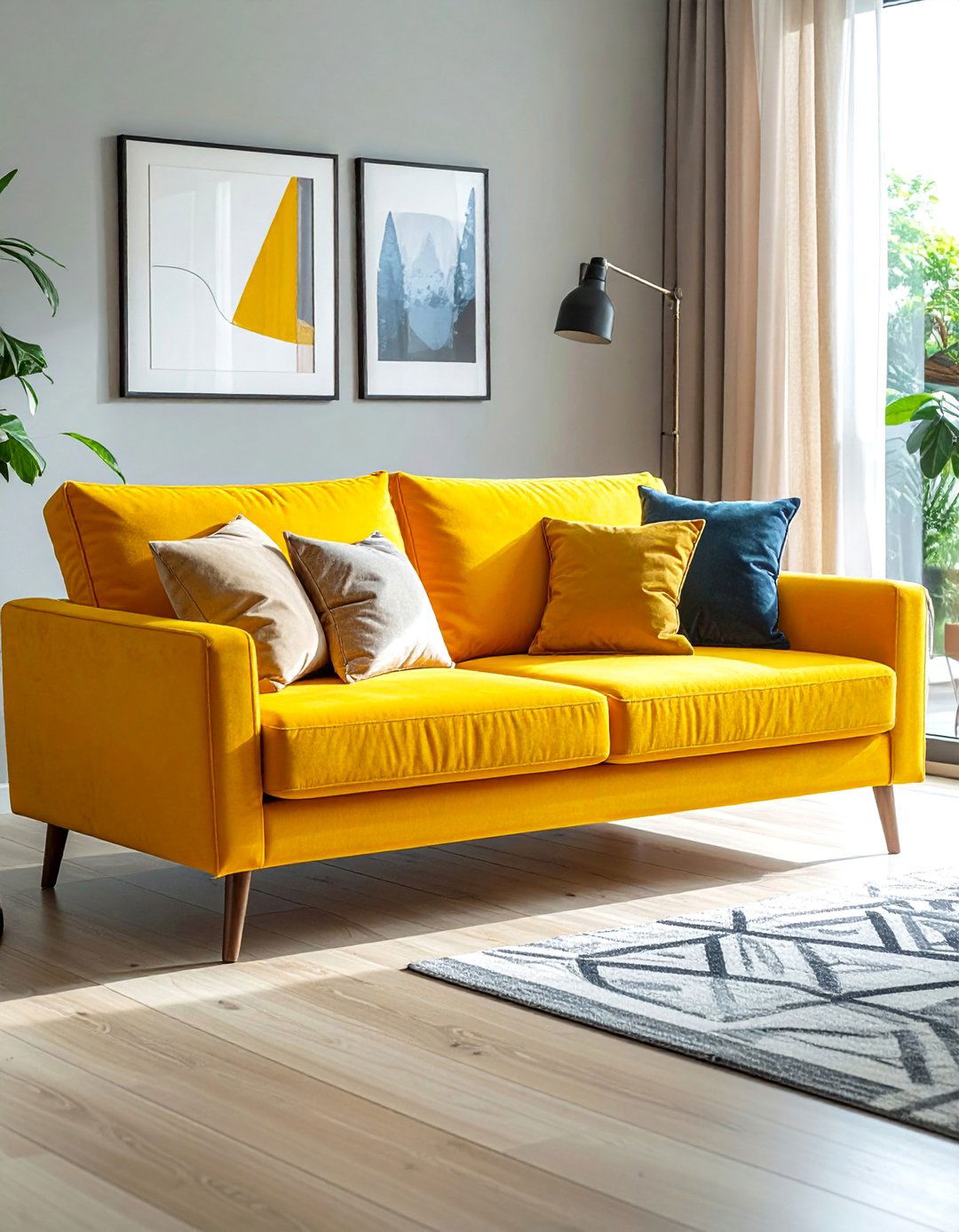
For those living in studio apartments or homes where the living room must also serve as a guest room, a pull-out sofa bed is an indispensable piece of furniture. Modern designs have come a long way from their lumpy predecessors, offering both comfortable seating and a proper mattress for sleeping. This dual-purpose item eliminates the need for a separate bed, freeing up the majority of the room for daily living. It's the ultimate space-saving solution, allowing you to host guests comfortably without sacrificing your primary living area. Choose a streamlined model that complements your decor.
28. Small Living Room with High-Gloss Surfaces
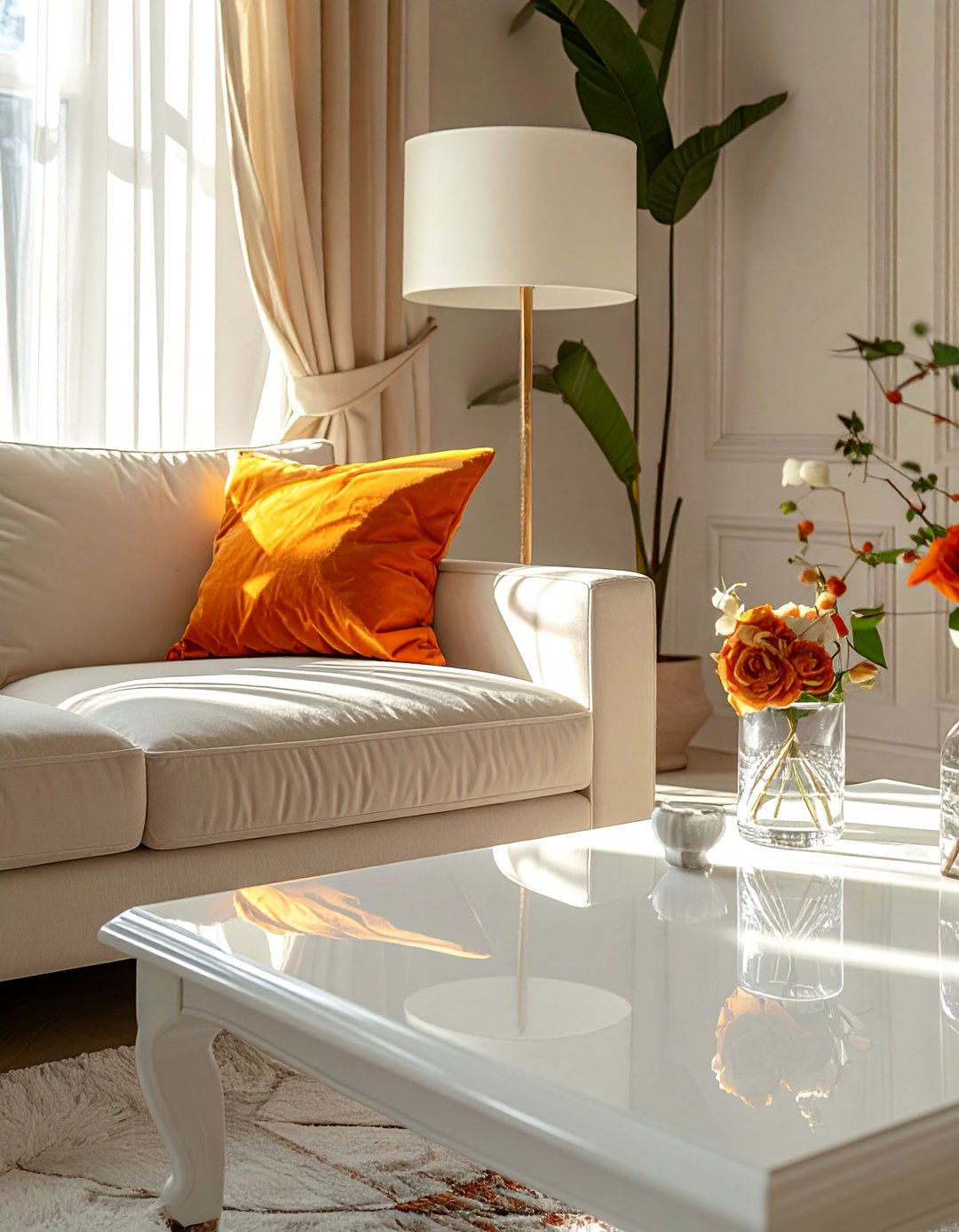
Incorporating high-gloss surfaces into a small living room can enhance the sense of space by reflecting light. A glossy coffee table, a lacquered media unit, or even a high-gloss paint finish on a wall or ceiling can bounce light around the room, much like a mirror does. This reflectivity adds a subtle sparkle and brightness, making the space feel more open and dynamic. These sleek surfaces contribute to a modern, glamorous aesthetic while serving a practical purpose in a compact environment. They help to amplify both natural and artificial light, creating a livelier and more expansive atmosphere.
29. Small Living Room with an Open-Back Bookshelf
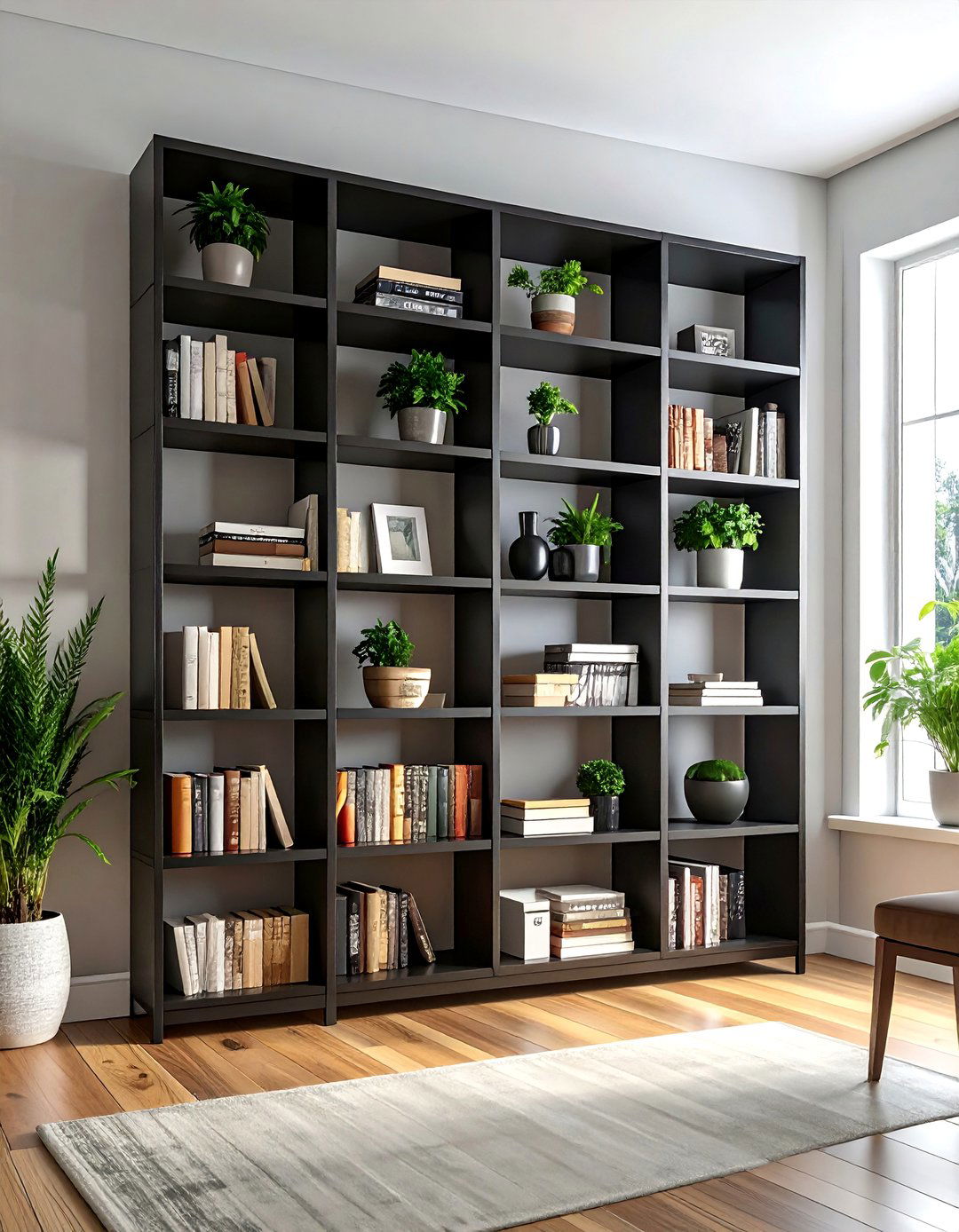
An open-back bookshelf, also known as an etagere, is a fantastic alternative to a solid, heavy bookcase in a small living room. Its open design allows light to pass through and lets you see the wall behind it, preventing it from visually dividing the space. This creates a much lighter, airier feel compared to a traditional closed-back unit. Use it to display books, plants, and decorative objects. It can also function as a subtle room divider in a studio apartment without completely blocking the line of sight, defining zones while maintaining a sense of openness and connection between areas.
30. Small Living Room with Ceiling-to-Floor Shelving
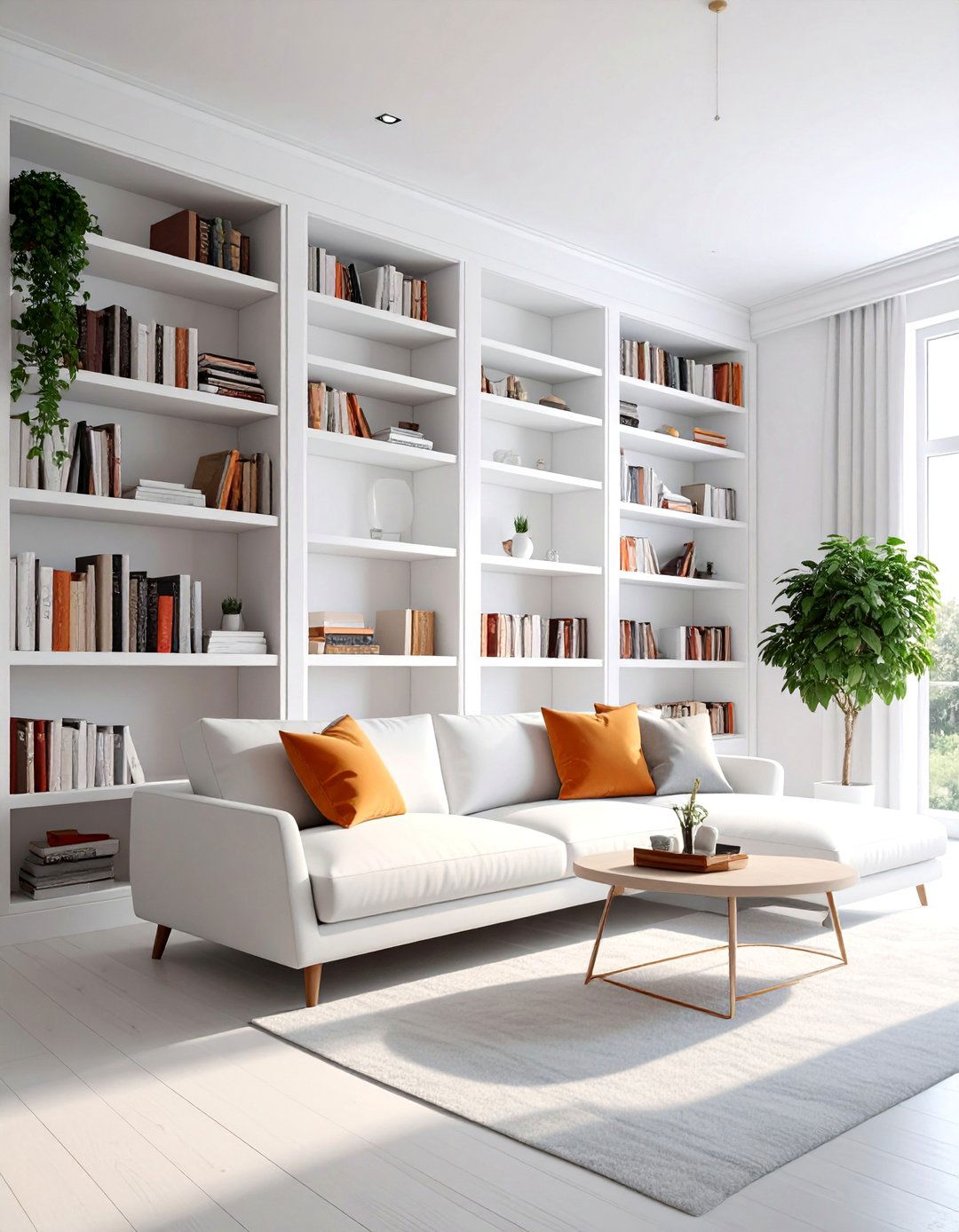
Utilizing the full vertical height of your walls is crucial in a small living room. Installing ceiling-to-floor shelving draws the eye upward, creating an illusion of a higher ceiling and a grander space. This type of built-in or freestanding unit offers a vast amount of storage and display area for books, art, and collections without taking up much floor space. Painting the shelves the same color as the wall can help them blend in seamlessly, reducing their visual weight. This approach not only provides a practical storage solution but also adds architectural interest and a sense of scale to the room.
31. Small Living Room with Minimalist Decor
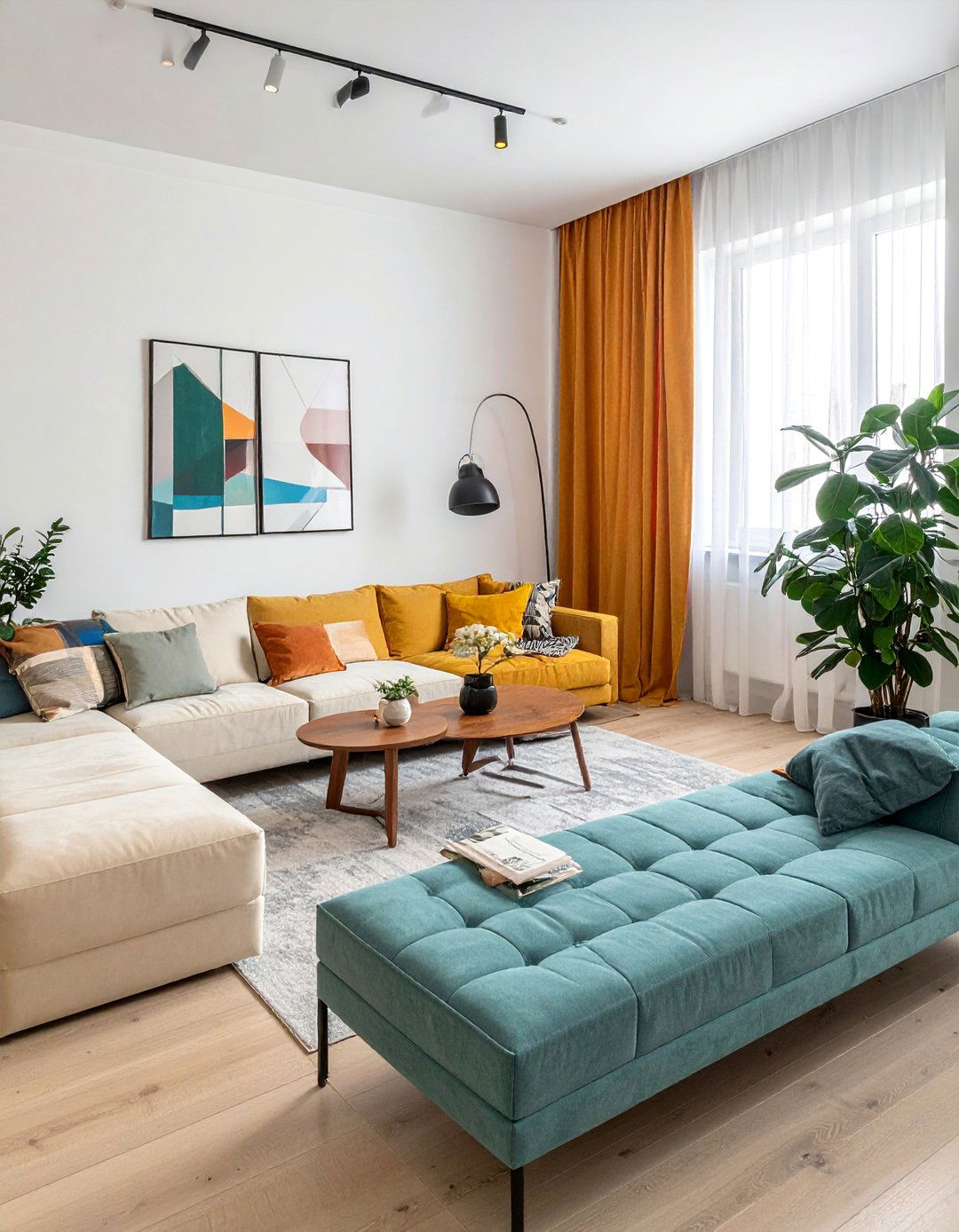
Adopting a minimalist decor approach is one of the most effective strategies for a small living room. The principle of "less is more" helps to eliminate clutter and create a calm, uncluttered environment. Focus on a few high-quality, meaningful pieces rather than an abundance of small, disconnected items. Keep surfaces clear and choose furniture with clean, simple lines. A minimalist aesthetic emphasizes functionality and intention, ensuring that every object in the room has a purpose and a place. This curated approach allows the space to breathe, making it feel more open, serene, and sophisticated.
32. Small Living Room with a Banquette Seating
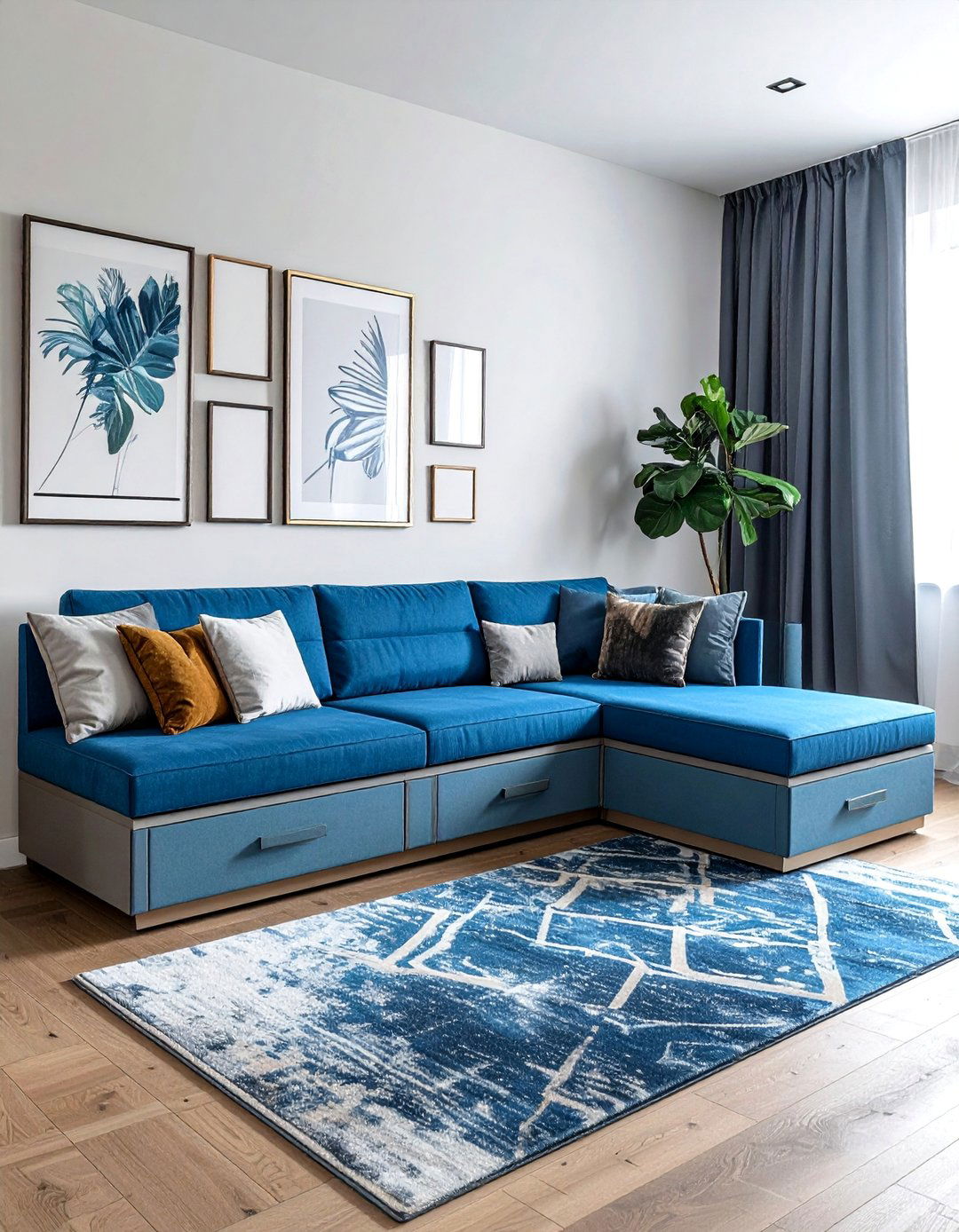
Banquette seating, typically built into a corner or along a wall, is a highly efficient way to maximize seating in a small living room. Like a window seat, it provides a large amount of seating in a fixed, compact footprint, often more than a sofa or multiple chairs could offer in the same area. The space beneath the bench can be equipped with drawers or lift-up lids for hidden storage. This custom solution makes excellent use of awkward corners and can create a very cozy, restaurant-booth-like feel, perfect for both lounging and entertaining a group of friends in a tight space.
33. Small Living Room with a Glass Top Coffee Table
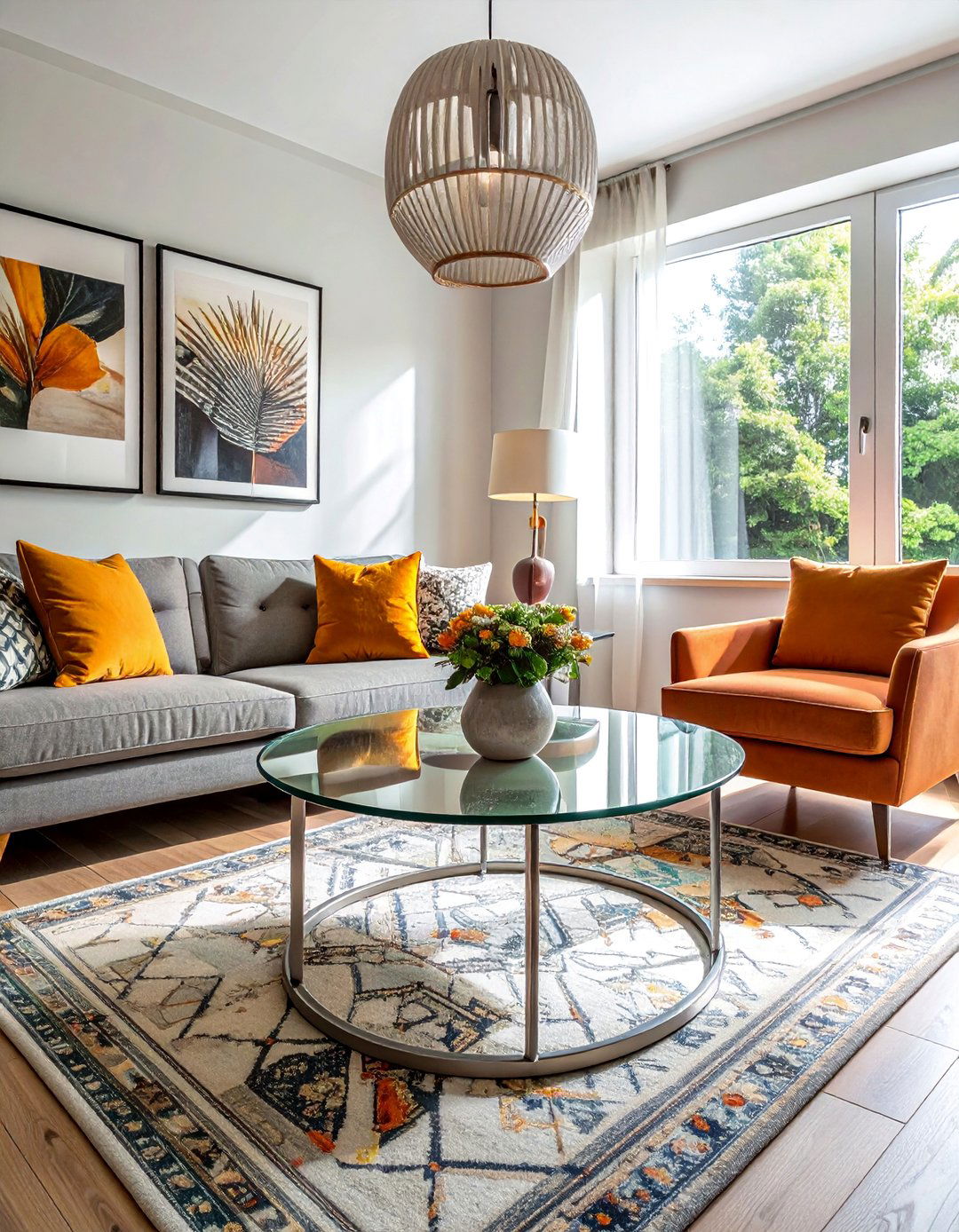
A glass top coffee table is a classic choice for a small living room because of its ability to create an illusion of space. The transparent surface allows the eye to travel through to the floor and rug underneath, which prevents the table from looking like a solid block in the middle of the room. This visual lightness helps to maintain an open and airy feel. Glass tables are also stylistically versatile, complementing a wide range of decor from modern to traditional. They provide the necessary function of a coffee table without adding visual clutter or bulk to your cozy living area.
34. Small Living Room with a Slipper Chair
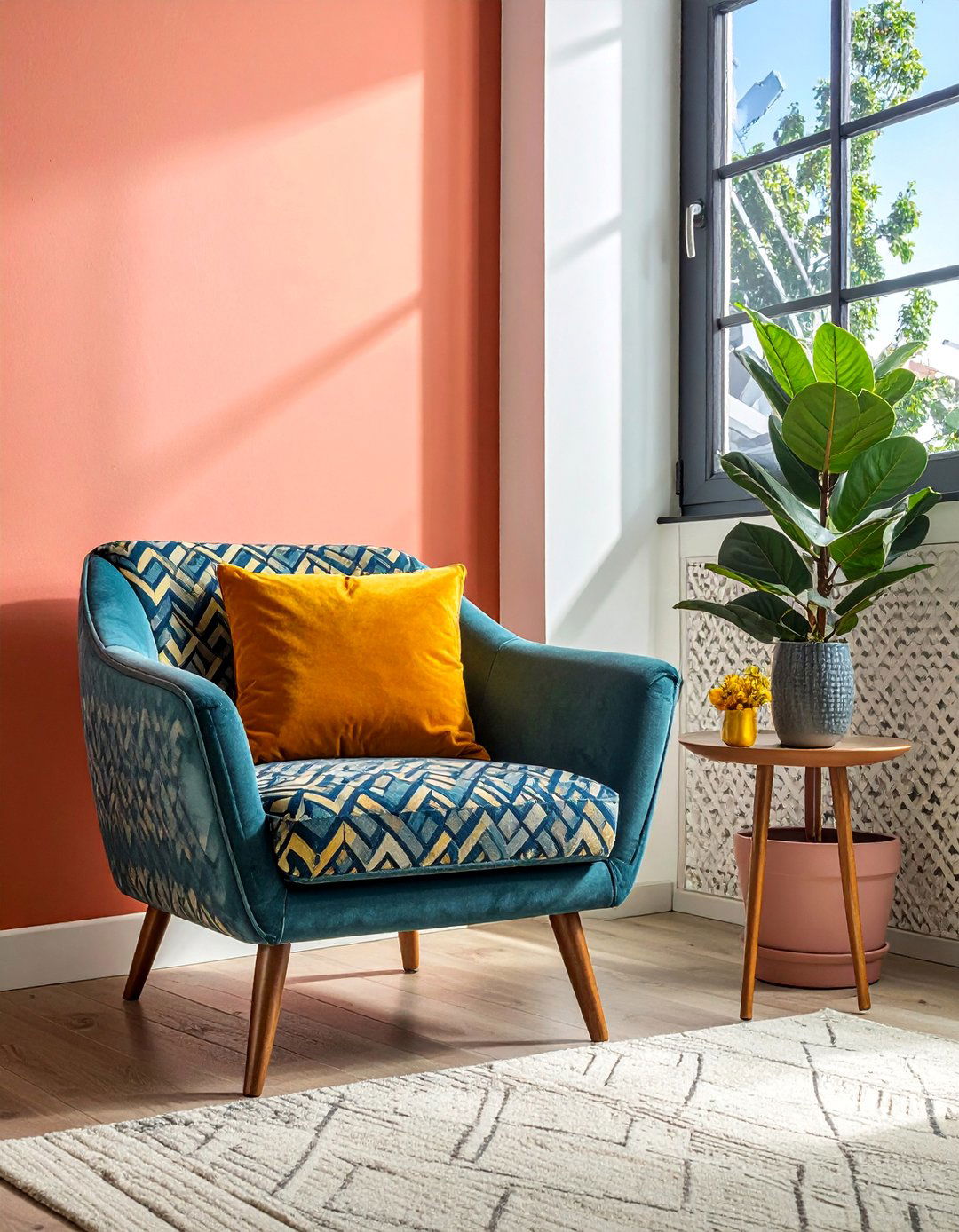
Slipper chairs are a perfect seating solution for small living rooms. These armless, upholstered chairs have a compact profile and a lower seat height, which makes them less visually imposing than traditional armchairs. Their lack of arms means they take up less physical space, allowing you to fit them into tight corners or place them closer to other furniture. Despite their small scale, they provide comfortable and stylish extra seating. They are easy to move around as needed, offering flexibility for different social arrangements. Their elegant, streamlined silhouette adds a touch of sophistication without overwhelming the space.
35. Small Living Room with a Coordinated Throw Pillow Collection
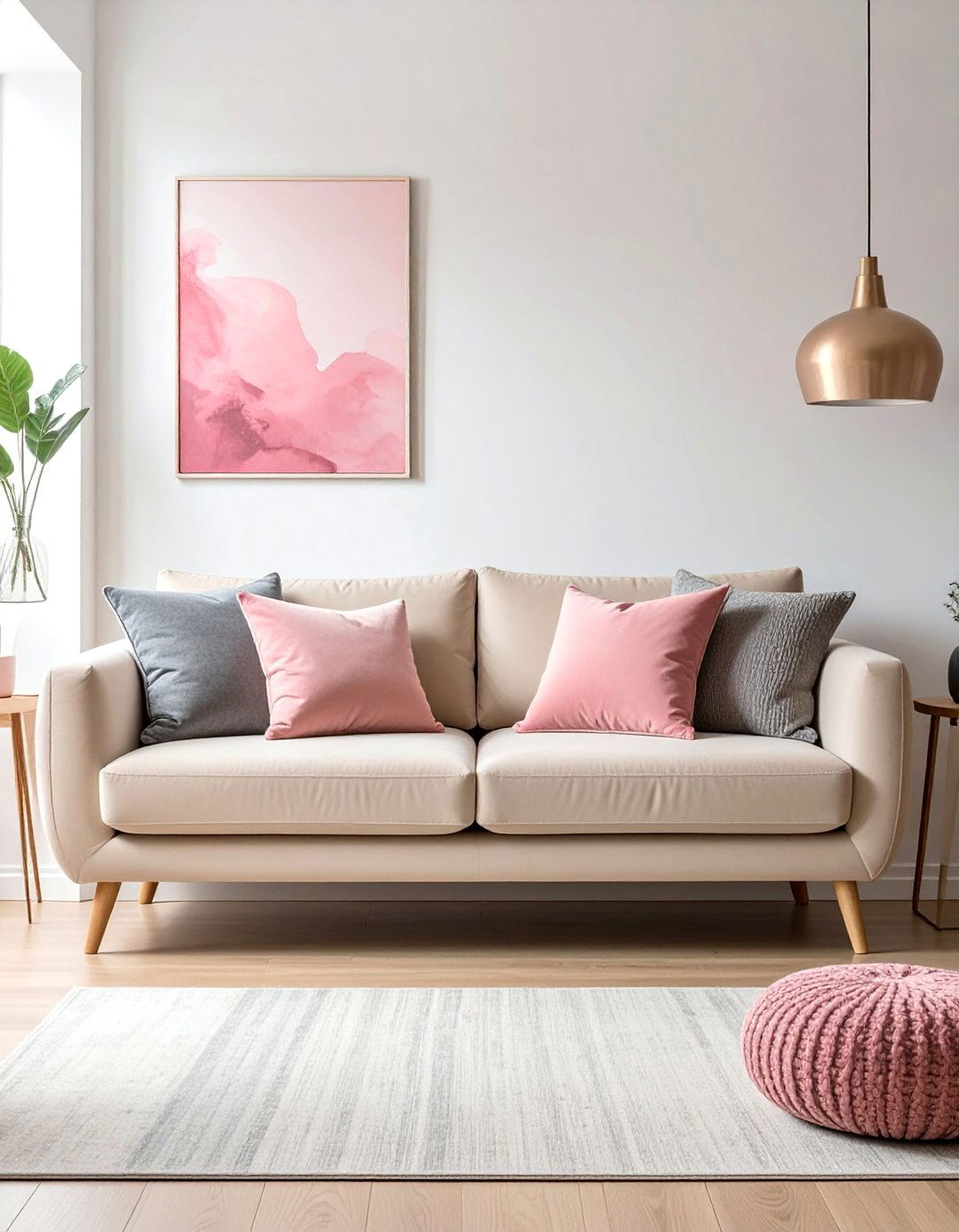
In a small living room, details matter. A well-coordinated collection of throw pillows can tie the entire space together and add a significant dose of style and comfort. Instead of a random assortment, choose pillows that adhere to your room's color palette. Play with different textures, sizes, and subtle patterns to create depth and visual interest without introducing chaos. This thoughtful approach to accessories makes the space feel more curated and intentional. It's a simple, low-cost way to inject personality and a sense of cohesion, making your cozy seating area look polished and inviting.
36. Small Living Room with a Round Accent Chair
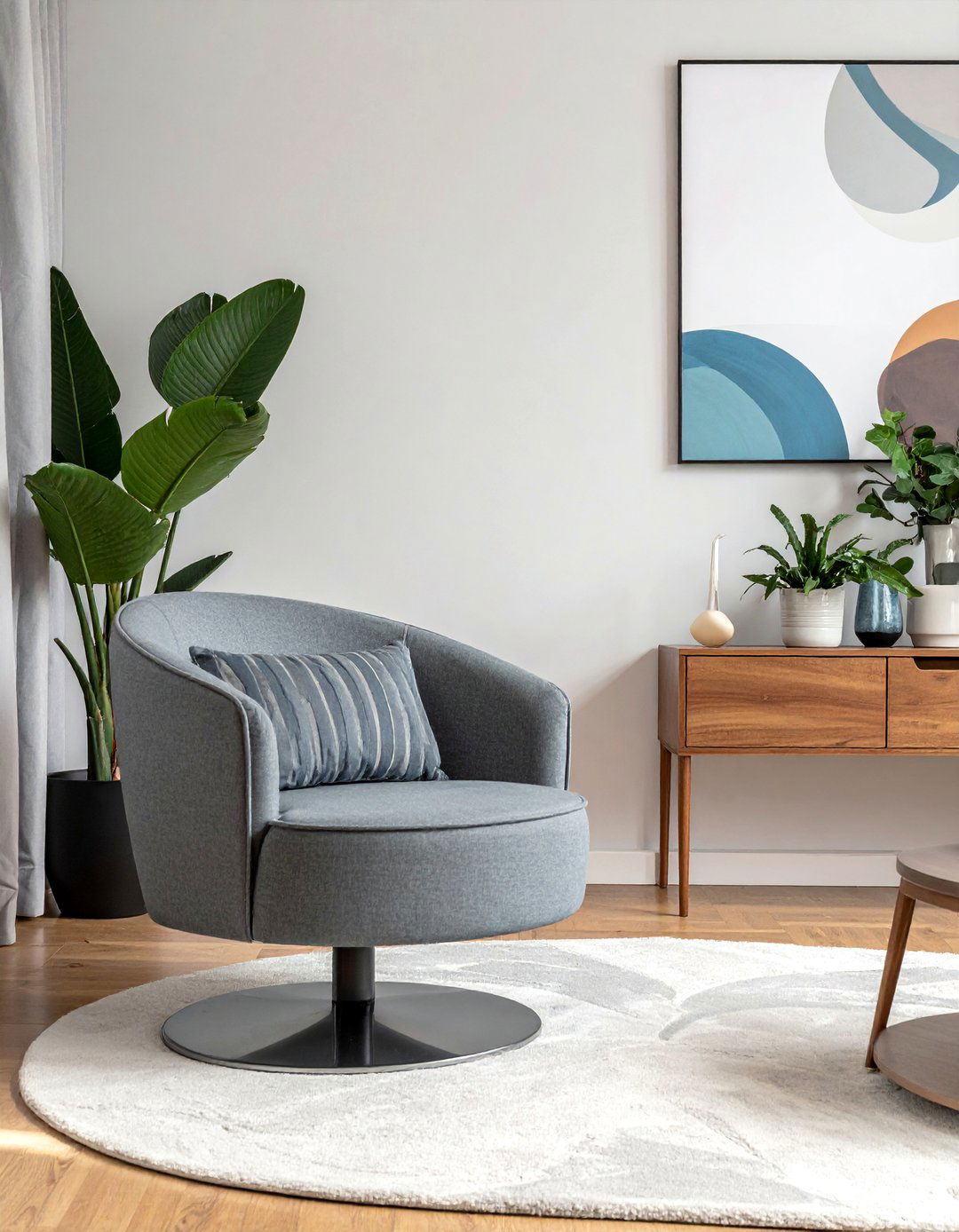
A round or curved accent chair, such as a swivel chair or a tub chair, can be a great addition to a small living room. The soft, rounded lines can break up the boxiness created by rectangular furniture and walls, adding a dynamic and more organic feel to the space. Swivel chairs are particularly functional in a small area as they can easily be turned to face a conversation area, the TV, or a window without having to be physically moved. This flexibility makes them a practical and stylish choice, offering comfortable seating while contributing to a more fluid and less rigid room layout.
37. Small Living Room with a Statement Light Fixture
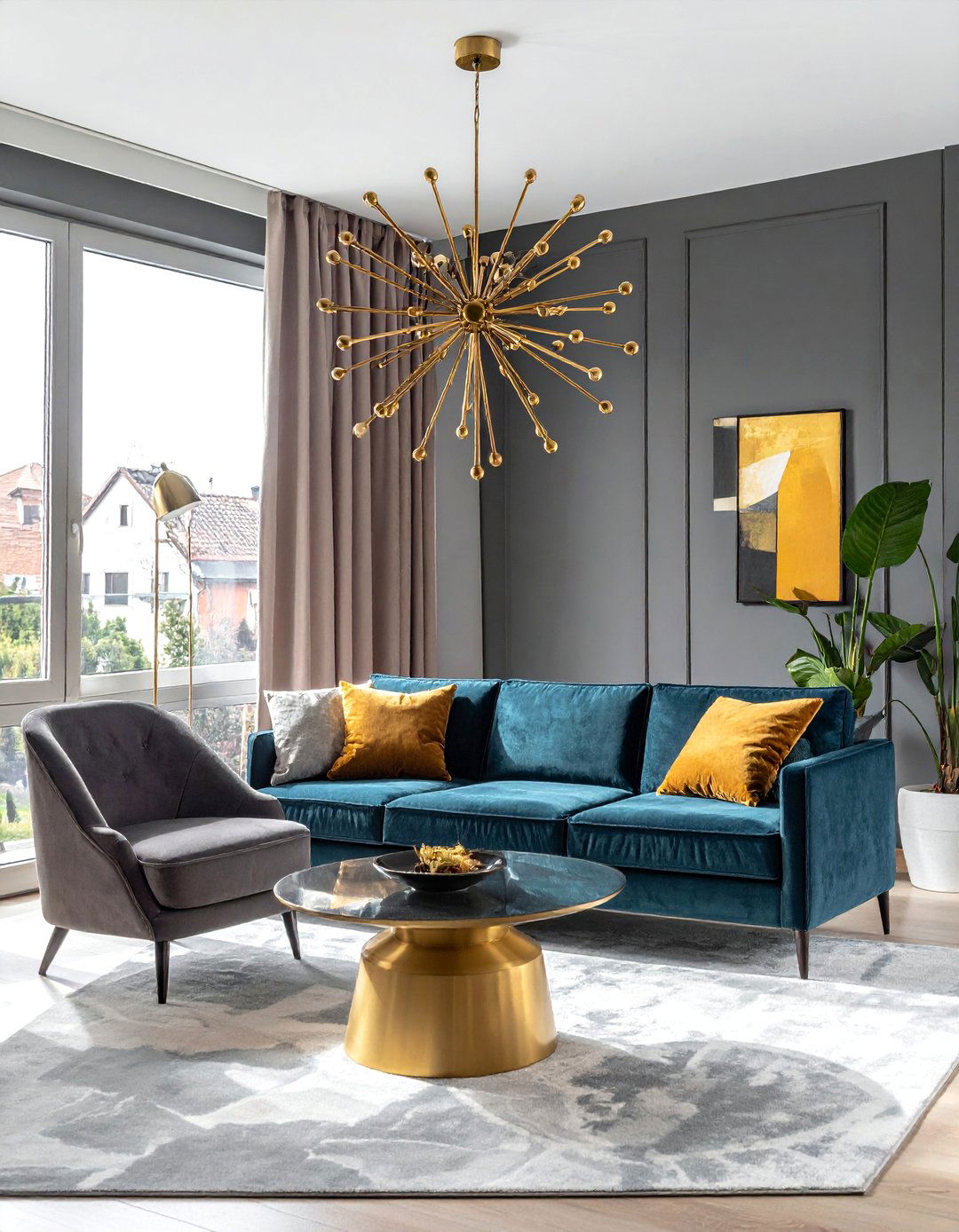
Drawing the eye upward with a beautiful statement light fixture is a fantastic way to add drama and a sense of height to a small living room. Replace a standard flush-mount light with a striking chandelier, a modern pendant, or a sculptural fixture. This creates a focal point in the upper portion of the room, making the ceiling feel higher and the space feel grander. It also adds a layer of sophisticated design that elevates the entire room. Ensure the fixture is scaled appropriately for the space—it should be impactful but not so large that it overwhelms the room or hangs too low.
38. Small Living Room with a Gallery Wall
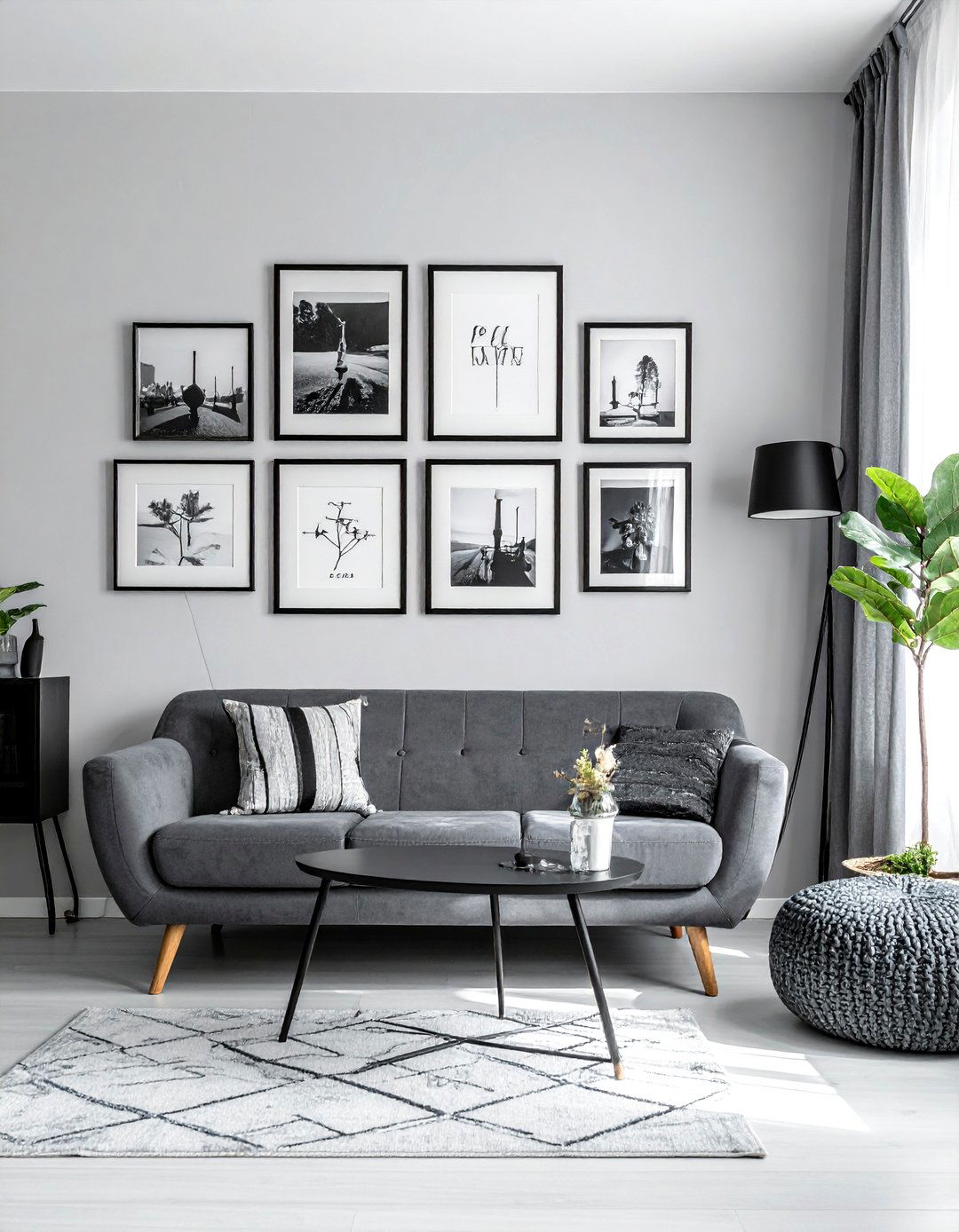
A gallery wall can be a wonderful feature in a small living room if executed correctly. Instead of using a large, blank wall, consider creating a gallery in a smaller, defined space, like above the sofa or in a narrow alcove. Use frames of a similar color or material to create a cohesive look. A mix of photos, art prints, and even small mirrors can add personality and depth. By grouping many smaller items together, you create a single, unified focal point that has more impact than scattering them around the room, which can look cluttered. This personalizes the space beautifully.
39. Small Living Room with Houseplants
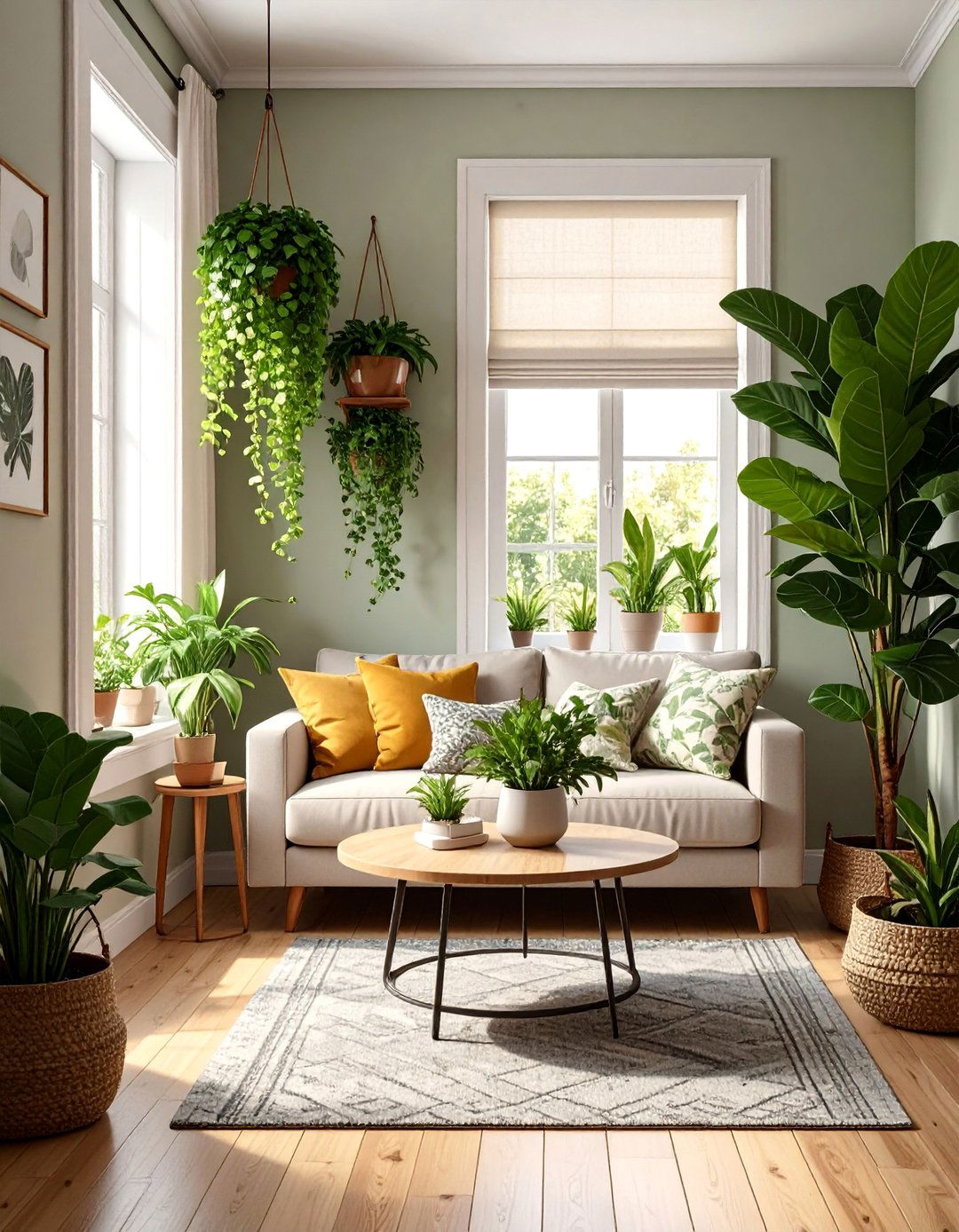
Bringing houseplants into a small living room is an excellent way to add life, color, and a sense of freshness to the space. Plants can help to blur the lines between indoors and outdoors, making the room feel more open. Utilize vertical space by using hanging planters or placing plants on high shelves. A tall, slender plant like a fiddle leaf fig or a snake plant can draw the eye upward, creating an illusion of height. The organic shapes and vibrant green hues provide a natural, calming element that can make even the most compact space feel like a tranquil, airy oasis.
40. Small Living Room with a Clear Furniture Layout
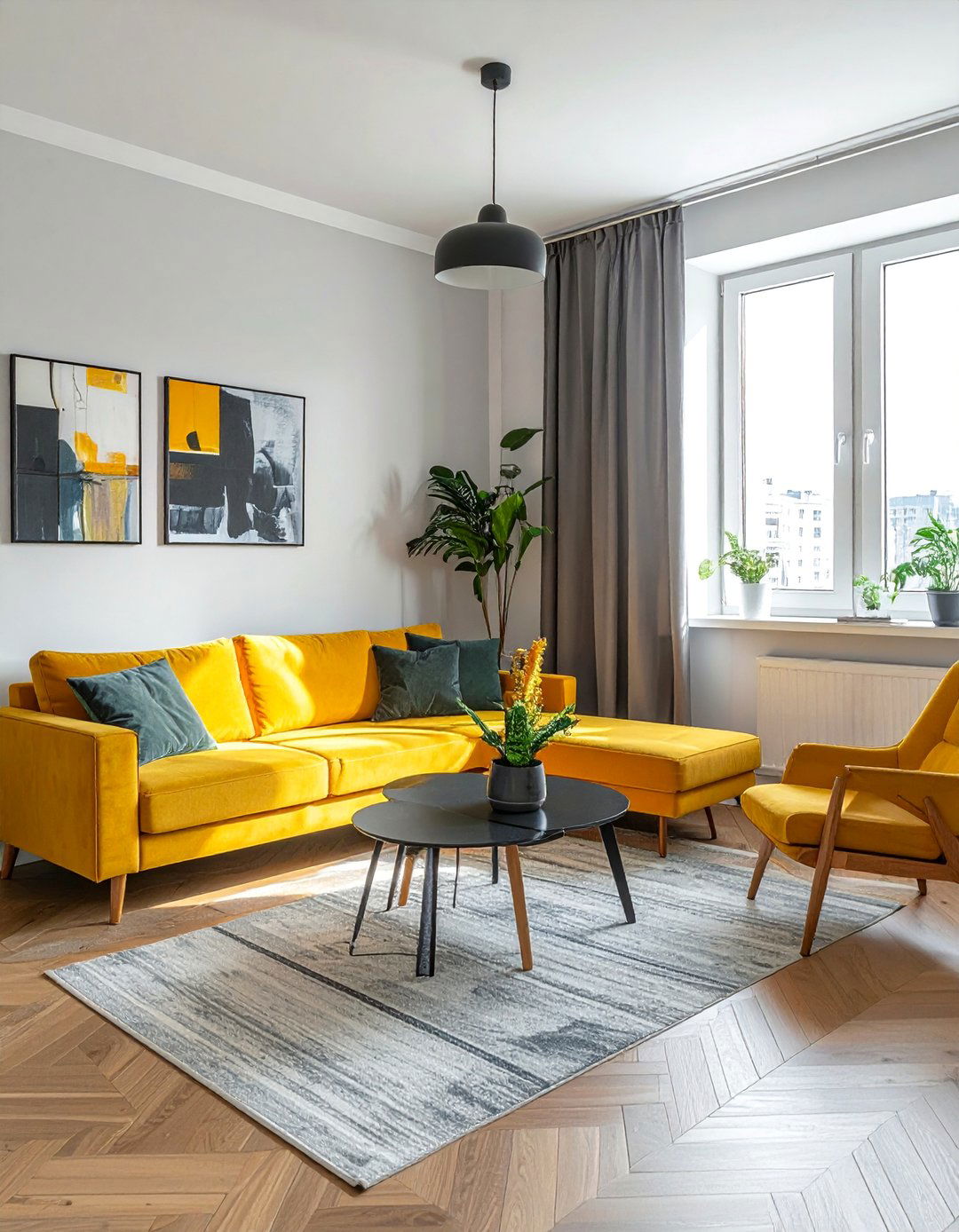
Defining a clear and functional furniture layout is perhaps the most critical step in designing a small living room. Pull furniture away from the walls, even if it's just by a few inches, to create a sense of breathing room. Arrange seating to facilitate conversation, typically in a U-shape or L-shape around a central coffee table. Ensure there are clear pathways for walking through the room without having to navigate an obstacle course. A well-planned layout not only maximizes the functionality of the space but also makes it feel more organized, intentional, and comfortable for everyday living.
Conclusion:
Creating a cozy and functional small living room is entirely achievable with smart design choices. The key lies in selecting appropriately scaled, multi-functional furniture, and using a light color palette to create an airy feel. Techniques like drawing the eye upward with vertical elements, maximizing light with mirrors, and maintaining a clutter-free environment are essential. By implementing these ideas, you can transform a compact space into a stylish, comfortable, and inviting haven that feels much larger than its actual dimensions, proving that size doesn't have to limit style or comfort.

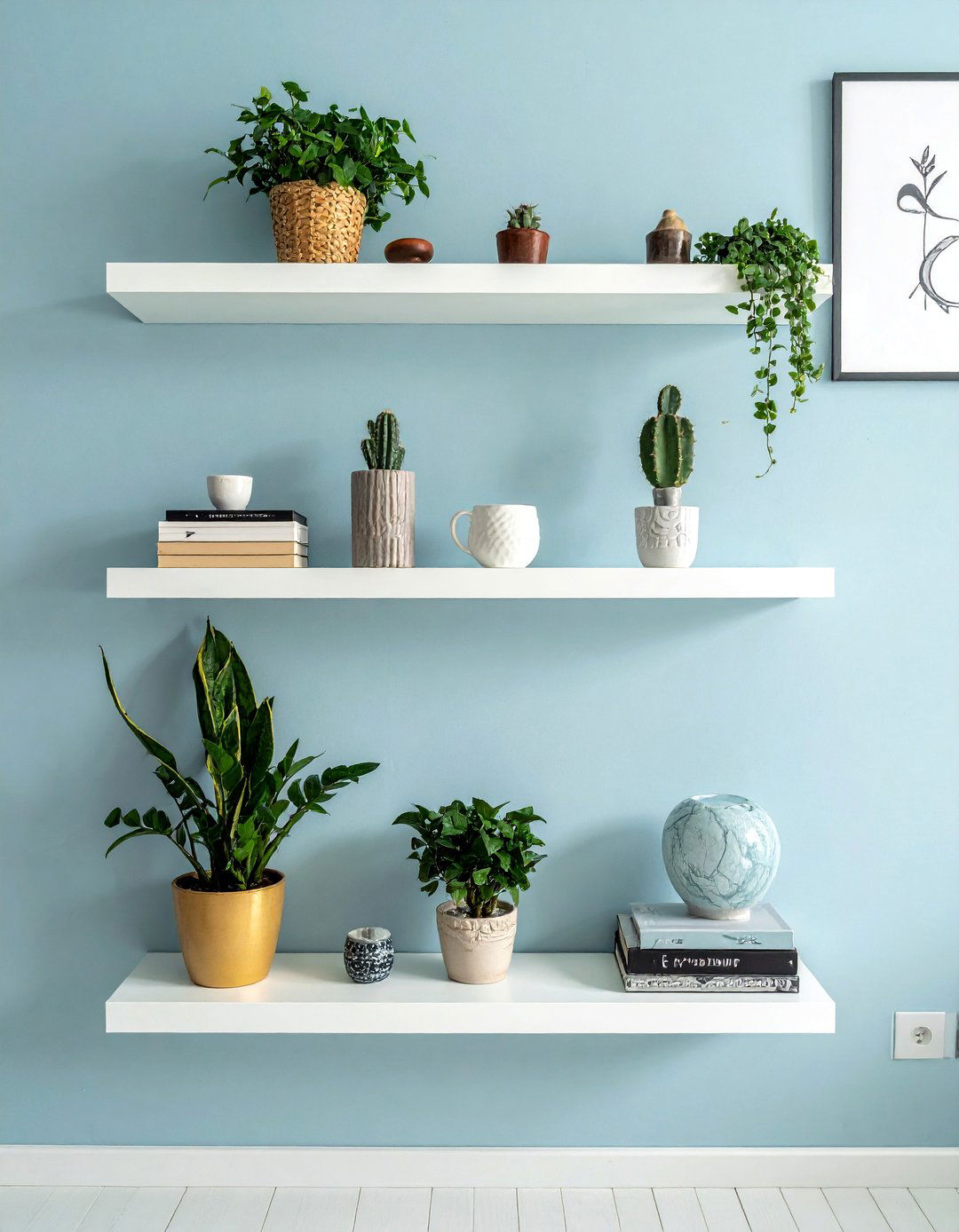
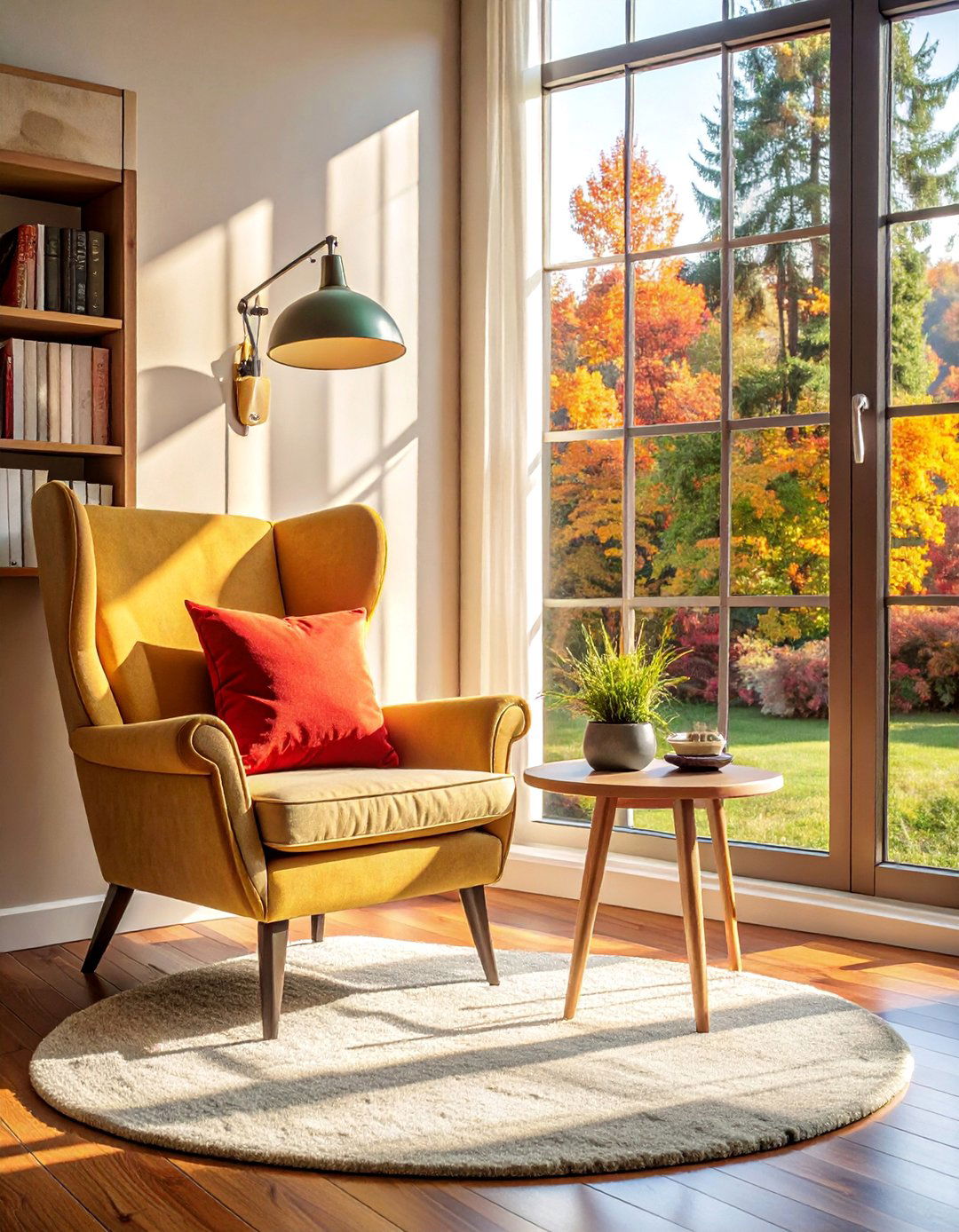
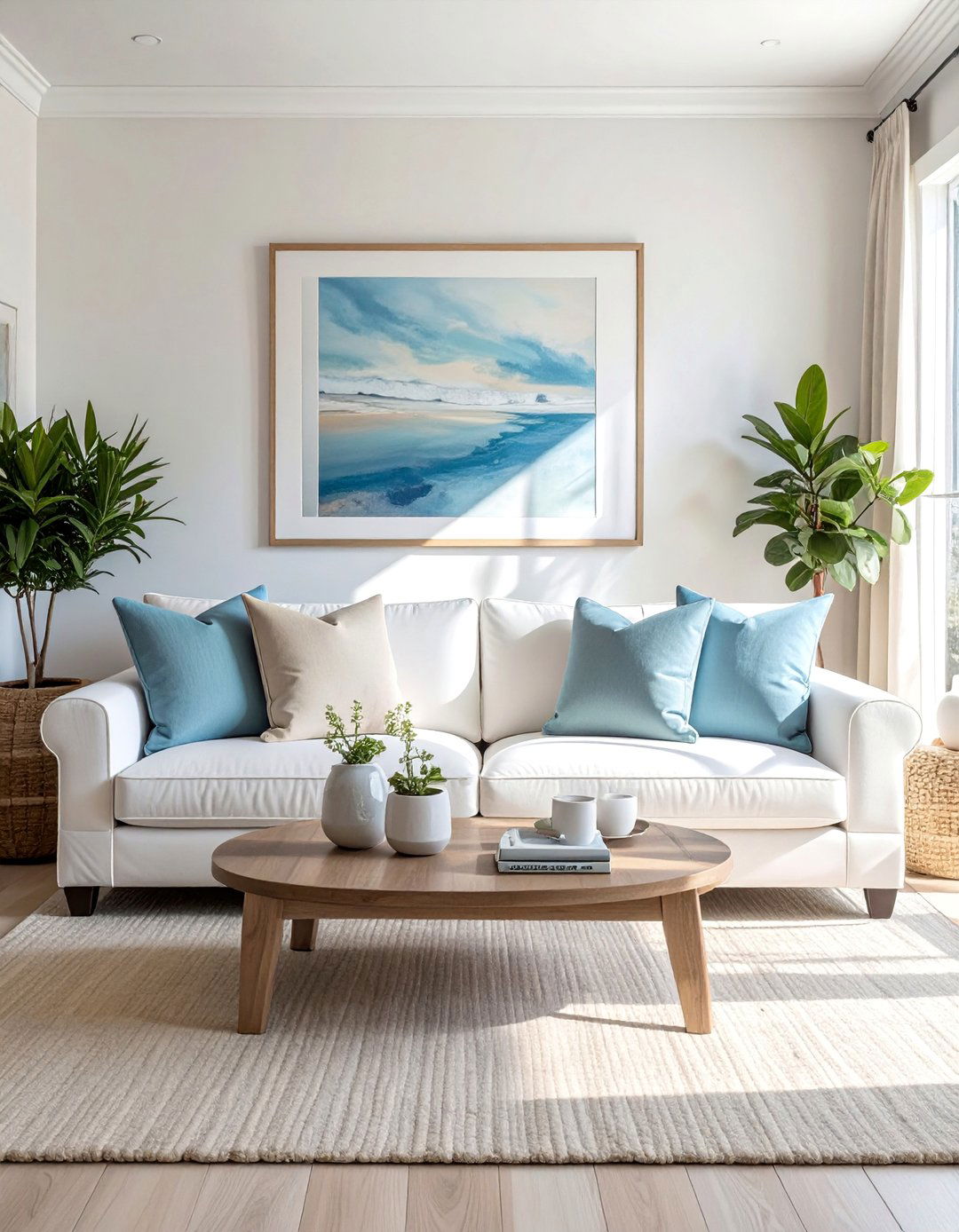
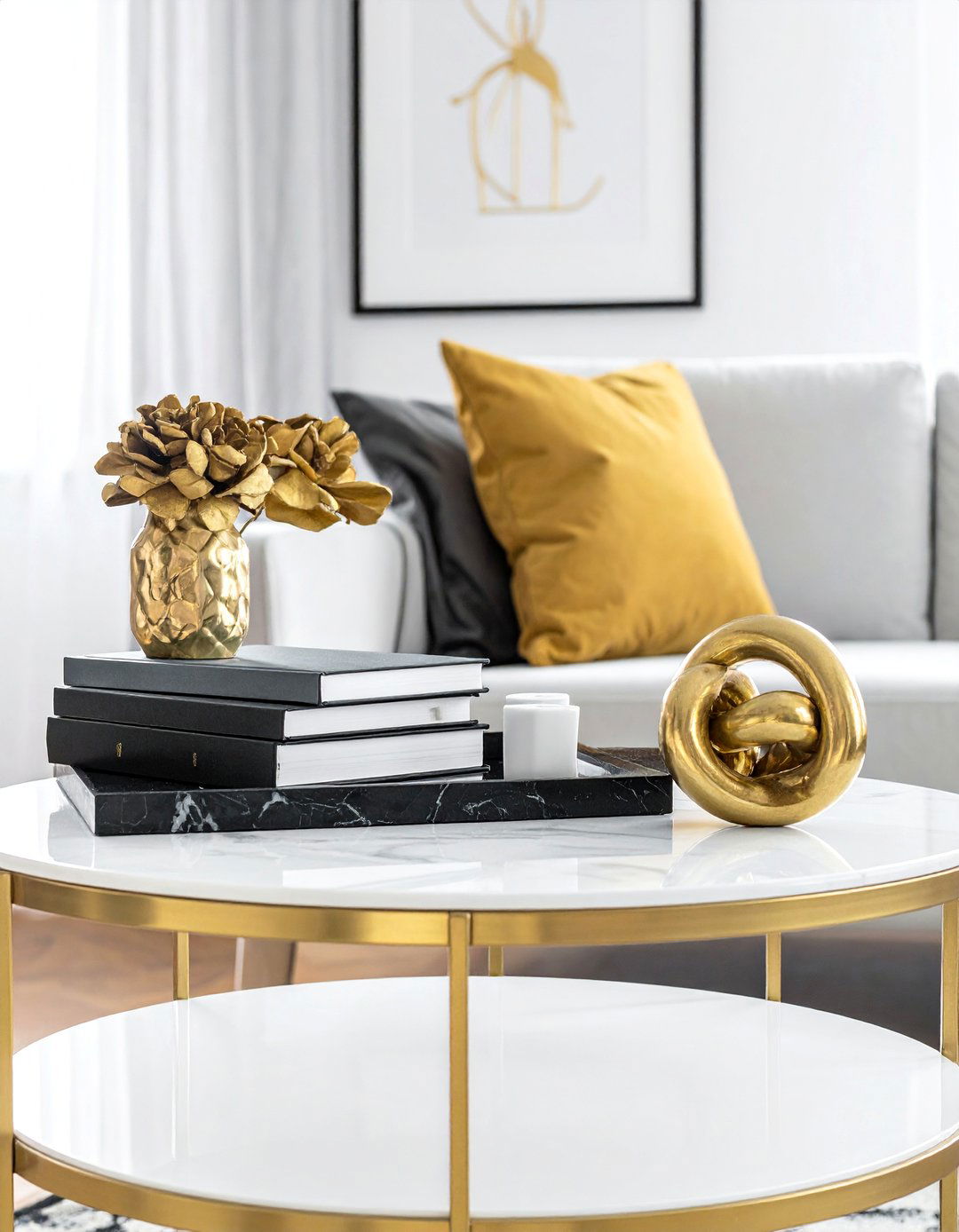
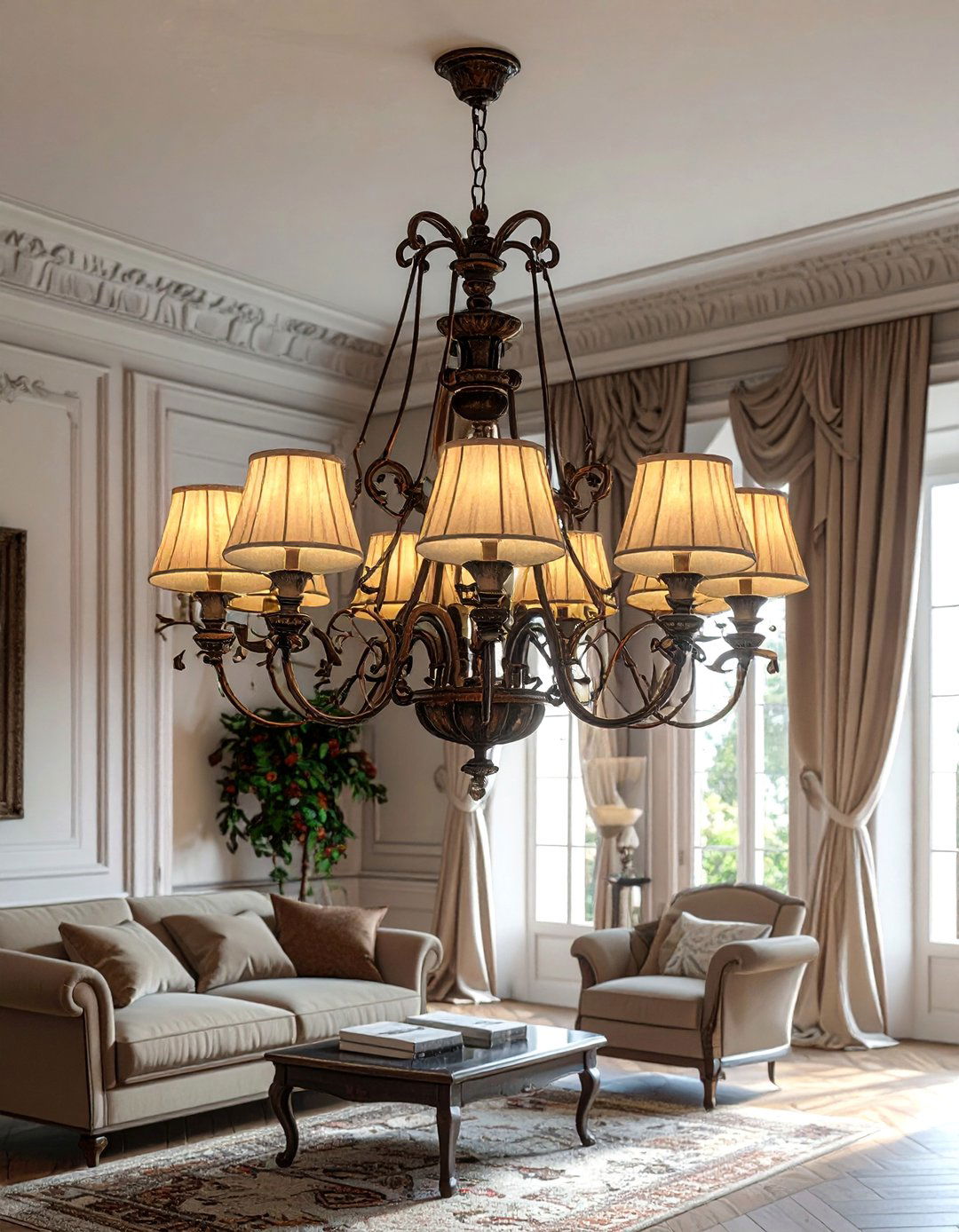
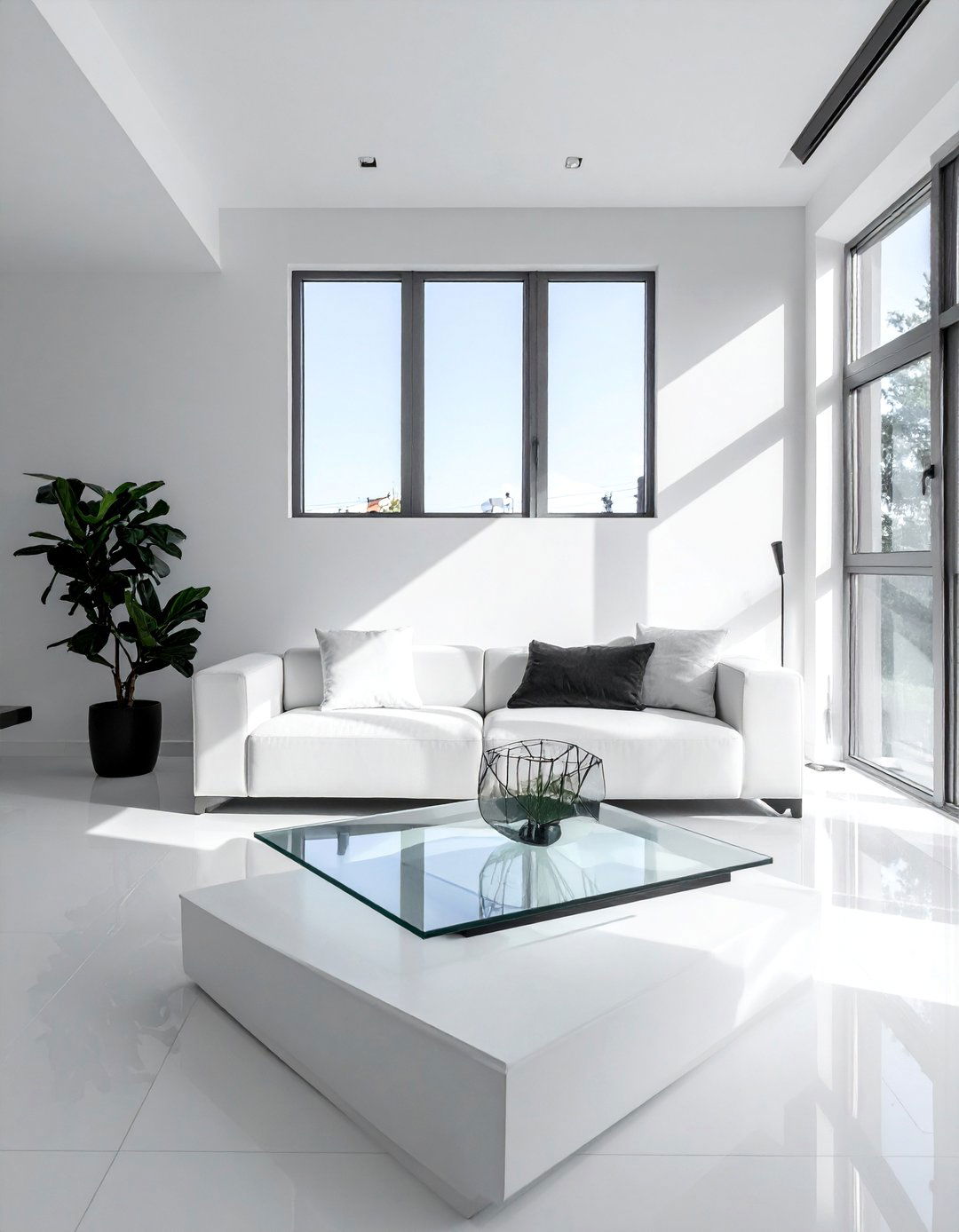
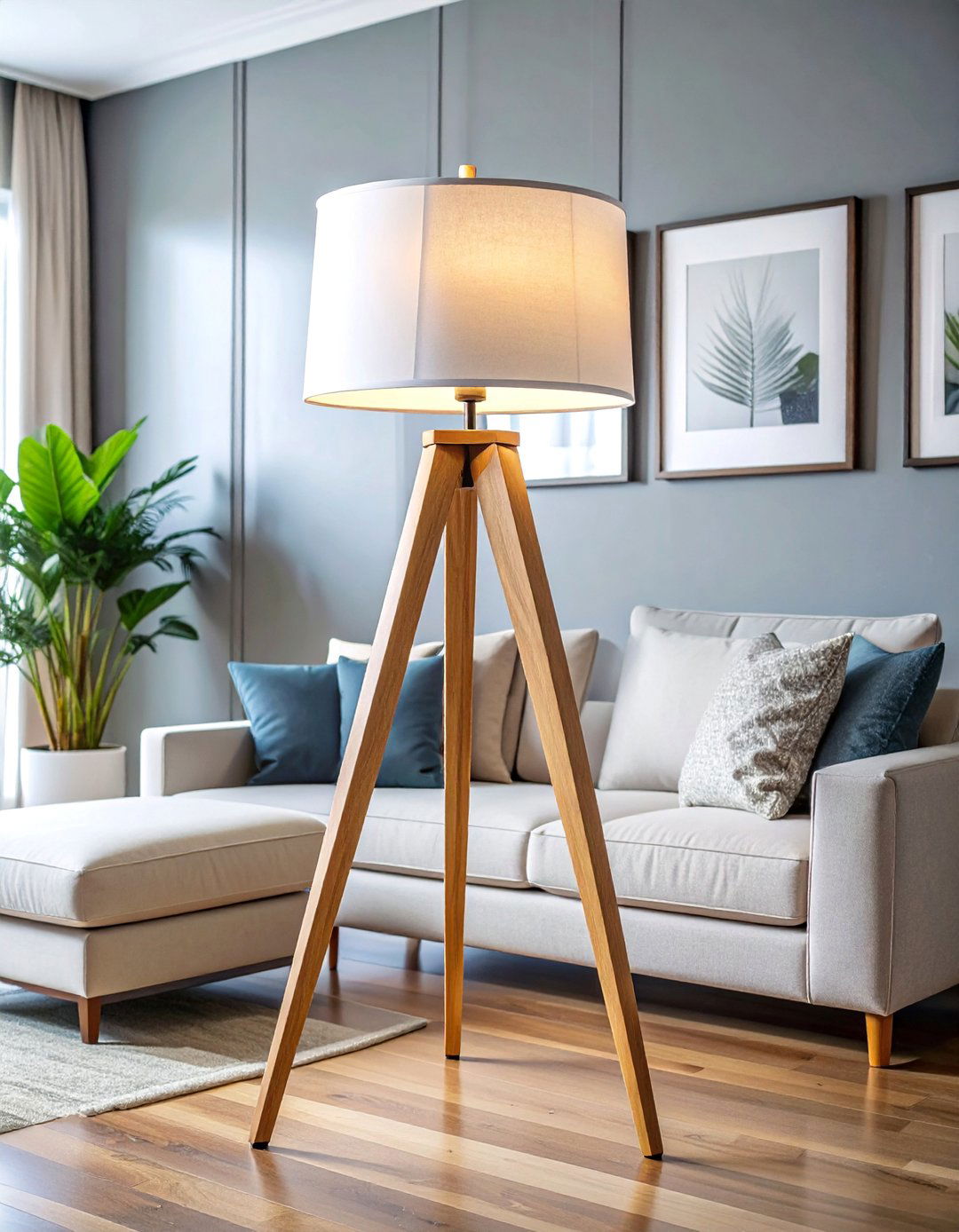
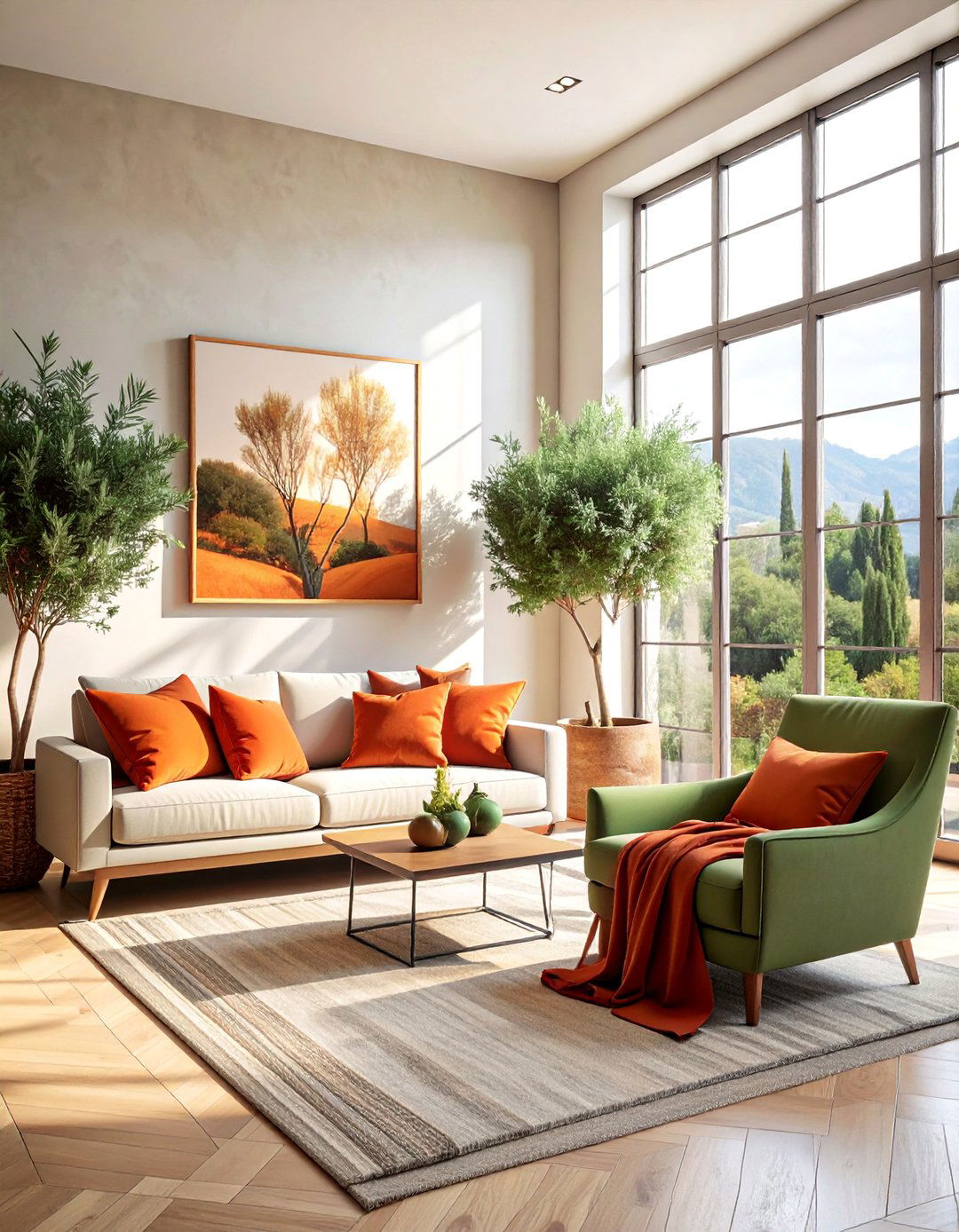
Leave a Reply